

Lonely Planet Travel Guide & App Review: Worth it in 2024?

One of the consumer staples of travel guides, Lonely Planet had once dominated the travel guide industry by providing inspiring and exciting guides for travelers around the world. Is Lonely Planet still the same today, and are their guides still worth it? Keep reading to find out.

If you’ve ever been to a bookstore, a magazine stall, or have watched TV, you’ve probably heard of the name Lonely Planet or Lonely Planet Guides.
Lonely Planet is a name that dominates the travel sphere on the internet, offering guides and informative content almost all around the world. Its popularity is largely due to its guidebooks with detailed maps that were considered a great resource for travelers, particularly for backpackers on a shoestring.
Today, it’s the world’s largest travel guide publisher with over 150 million guidebooks. It's basically a household name for travel guides.
But, as Lonely Planet’s ownership changed from time to time, it began to lose its appeal as a unique platform for travel content. After all, travel content has been fastly evolving, with popularity shifting from guides provided by large travel companies to guides provided by travel influencers and blogs.
So, I wanted to know if Lonely Planet is still a resourceful travel website ripe with information that’s relevant, timely, and budget-friendly. Are they still a thing people go to for travel inspiration and resource, or are they outdated?
How does Lonely planet compare to the newer travel guides in the market, like CN Traveler or NomadicMatt ? Keep reading to find out if Lonely Planet travel guides are still worth purchasing!

What Is Lonely Planet?
Lonely Planet is a travel guide and travel content publishing company that was founded in 1973 with the aim of providing travelers with useful, unique, and non-mainstream information along with affordable authentic choices for accommodation and dining.
They house a collection of experiences, expressed through the passion of lonely planet themselves, that helps travelers worldwide make the most out of their trips.
Started by two broke backpackers on a trip from England to Australia, Tony and Maureen Wheeler, had a vision to provide fellow travelers with inspiration to travel. Lonely Planet quickly rose through the ranks due to its depth of content, originality, and abundance of practical advice while traveling.
It was eventually sold to BBC and then to a billionaire, Brad Kelley during the global recession. Brad then infamously assigned CEO to a 24 year old ex-wedding photographer. That's a whole different story that I won't go into detail, but you can read the interview here!
If you are wondering who owns Lonely Planet at present; it’s Red Ventures, an owner of many digital businesses.
Where Can I Find Lonely Planet’s App?
Lonely Planet has also developed an app to digitize all of their travel guides for the convenience of their guides on the go.
The Lonely Planet’s app is called “ Guides by Lonely Planet ”, which can be accessed from both iOS and Andriod devices. In here, you'll find their usual guidebooks, like their Asia or Europe collection.
To make travel more accessible for Lonely Planet’s users, they’ve also included their phrasebook guides inside their app, which allows users to learn and use local phrases of countries they’re visiting.

Is the Lonely Planet App Free?
The Guides by Lonely Planet app is free and available to access for some guides on the platform. However, a full paid subscription is required to gain full access to the app’s features and all of the guides and partner discounts offered by Lonely Planet.
Lonely Planet currently has 3 subscription plan, which includes:
- 1-Month Subscription Plan - 3.99$
- 6-Months Subscription Plan - 19.99$ (Save 16% from the monthly subscription)
- 12-Months Subscription Plan - 29.99$ (Save 37% from the monthly subscription)

What Are the Main Features of Lonely Planet?
Guidebooks and maps.
Lonely Planet sells guidebooks on regions, countries, cities, parks, hikes and treks, and many other topics in both digital and print form. These include itineraries, maps, user reviews, insider tips, and information on hidden gems!
Here are just some of the different guidebooks they're selling:
- Lonely Planet Japan
- Lonely Planet South America
- Lonely Planet The Caribbean Islands
- Lonely Planet Portugal
- Lonely Planet The World
One cool book I'd recommend is their annual bestseller " Best in Travel " guidebook (they're available online ), which is one of their annual list of bestsellers of the best countries, cities, destinations to visit of the year. They cover tons of topics, from the best value destinations of the year to sustainable travel choices you can make to help make travel more inclusive for others.
If you are an old-school traveler who likes to flip the pages of paperback devouring travel content, you can order its print versions. Otherwise, you can go with the ebooks , especially if you are backpacking. Maps can be purchased separately as well.
Booking can be made via Lonely Planet related to insurance, hotels, flights, adventure tours, sightseeing tours, and transport. So, if you come across interesting experiences or points of interest while going through its content, you can place a reservation directly.
Inspiring Travel Content
In addition to Lonely Planet travel guide books that users have to pay for access to, Lonely Planet also provides extensive travel descriptions, articles, and videos covering topics related to different destinations that are free to view.
Users can purchase and access Lonely Planet travel guides via its website or mobile app, which is available in both Android and iOS versions. General content related to destinations can be viewed even without an account for free.
What Additional Features Can You Get With a Lonely Planet’s Subscription?
While Lonely Planet’s guides and services are free to use, a lot of their guides and features come with a paid subscription. But what exactly are these features, and what more can I get from the paid subscription of Lonely Planet?
Keep in mind that subscriptions purchased on either the Guides by Lonely planet app or the Lonely Planet website are the same and purchasing subscriptions from either platform will give you full access to both.
Here’s the list of all the extra features that come with the subscriptions:
- Full access to all 8000+ cities and the points of interests
- Full and unlimited access to all the guides + Lonely Planet TV
- Access to Magic FX, virtual tours, and budgeting tips
- Access to Lonely Planet phrasebooks

What Is Missing in Lonely Planet Today?
Updated information.
One of the frequent complaints about Lonely Planet by its avid users is how the guidebooks have lost their novel touch. I'd honestly go as far to say Lonely Planet has lost its touch.
Information and tips mentioned in newer editions are outdated and uninspiring. If a guidebook that you purchase for eye-catching information has only generic, old, and mainstream facts that you can gather with a quick search on the internet, then it’s obviously not worth the money.
They've also seemingly adopted a quantity over quality angle through their digital guidebooks, recommending an endless lists of things to do in certain places like New York or Paris, with very little actual content as to why they're recommending it.
If you have ever purchased or viewed some of the earliest guidebooks (old versions) by Lonely Planet, you would see that they’re almost always full of colorful and detailed information, inspiring you to travel.
In terms of trustworthy information goes, I'd rather read a Google, Yelp, Quora, and even a Reddit user review before going with Lonely Planet's recommendation.
But, if you take a look at the more recent versions, you’ll no longer see the same page-flipper content that you’re normally used to on the original Lonely Planet guides.
Useful Details
One of the aspects that used to set Lonely Planet apart from its counterparts from the start was the depth of its travel content.
Their original guidebooks were a treasure trove of information on places with descriptive and useful explanations. Not to mention, the authenticity of places recommended were always protrayed through incredible visuals or storytelling techniques.
Back then, Lonely Planet truely reflected the excitement of a passionate global community of travelers giving out helpful and inspiring recommendations.
At present, its descriptions are vague narratives that are written poetically but lack the necessary details we need. There is less emphasis on unusual attractions and insider tips that many readers look for in purchasing a guide, especially one that was made by Lonely Planet.
Handpicked Attractions
The list of attractions provided by Lonely Planet is nothing short of overwhelming, especially if it’s a popular destination.
While it does give us a plethora of choices to choose from and create our own itinerary, it would have been better if Lonely Planet sifts the best for us as a travel company that knows better than its users. There’s the choice of filtering the attractions based on categories but that doesn’t help us from choosing destinations that are actually worth visiting.
Lonely Planet has, in my opinion, appropriated mainstream travel content and booking websites and lost its defining competitive edge as a result. It’s no longer the expert who knows how to “guide” travelers away from dull and uninspiring spots and help them experience the true essence of the destination.
Localized Recommendations
Lonely Planet guides also provide accommodation and dining options that can be booked from the website directly. However, its knack for providing affordable and unique choices for travelers looking for a localized experience has diminished greatly.
Users also complain how Lonely Planet’s choices are overcrowded and highly commercialized places or ones that no longer exist.
Prompt Service
After reading many Lonely Planet reviews, it seems that even the customer service is subpar. Many customers have complained of delayed shipments of guidebooks they ordered, irresponsive and unreliable customer care team, and time-consuming refund process. This has further downgraded Lonely Planet and discouraged people to purchase its guides.
It’s also noteworthy to mention that Lonely Planet has gone through what any company goes through with a change of ownership – a change in objectives, values, and business model. So, the ideas cherished by its founders may not align with its present parent company – a highly commercialized enterprise

What Else Has Changed?
There are other factors that have affected the popularity of Lonely Planet.
Consumer expectations have increased rapidly over the past years with the growth of the travel industry as well as technology. It may be that printed guidebooks are no longer deemed as essential resources when there are resources on the internet that won’t affect the weight of your backpack.
Lonely Planet has lost its charm to hook readers with its resources is the influx of travel websites we have experienced over the years. There’s information everywhere, and Lonely Planet has been unable to compete well enough to retain its edge.
More importantly, its competitors like Rough Guides, Bradt, and DK Eyewitness Travel have also been performing really well, filling market gaps. When it comes to Rough Guides vs Lonely Planet, some prefer the former for better accommodation options.
Depending on the kind of traveler you are, you might or might not find them useful. I personally don't.

What’s Still Good About Lonely Planet?
Great platform to get an overview.
For those who are simply browsing for travel content on a particular country, city, or attraction, Lonely Planet may be a good place to get a comprehensive introduction.
It rounds up information on history, culture, wildlife, and other major aspects that are worth the attention while giving a long list of attractions below for you to gain a better picture.
If you prefer to gain all the basic details in one place rather than strip-searching the internet, Lonely Planet is a good site.
Covers All Destinations
It’s unlikely that Lonely Planet won’t have a description for a destination you are looking for – although it may be short of a detailed travel guide.
It’s due to this very reason that travelers continue to use the website and get a heads-up about places they intend to visit. So, while it is increasingly syncing with mainstream travel sites, the behemoth of information Lonely Planet has worked in their favor.
Due to this, Lonely Planet still remains one of the frequently used websites by travelers around the world.
Visual Content
Lonely Planet is a great place to watch inspiring videos and learn about wildlife attractions, cultural events, natural wonders, and other interesting aspects around the world. For those of us who don’t necessarily enjoy reading lengthy articles, the videos of destinations and facts about them can be a feast for the eyes.
Trip Planning
Despite the inaccuracies that have been noted in some guide books and maps, people continue to refer to Lonely Planet to supplement their travel plans. The maps have proven to be useful – although they could be much better. You can use the website to select what appeals to you and include it in your itinerary. Its booking features also make travel planning a step easier.
If you are looking for a travel planner that also provides tons of guides and insider information on places to visit, eat, and stay, you’ve come to the right place! Pilot is a social trip planner which also offers reviews and guides that can help travelers make better decisions and plan better trips.
Is Lonely Planet Still Worth It?
Having known all of this information about Lonely Planet and its travel guides and travel apps, you’re probably wondering if Lonely Planet guides are still worth it. Above that, is Lonely Planet’s paid subscription still worth the money?
From a free travel guide’s perspective, we believe that it’s still worth checking out. They contain beautiful visuals and a big picture overview of many destinations around the world and could help you decide where you want to visit.
From their paid subscription’s perspective, we believe that there are better options out there, especially when it comes to their guides and point of interest. There are newer blogs with better recommendations when it comes to places to visit or stay in a destination.
For example, our blog of Airbnb recommendations in Paris offers cool budget accommodations in Paris that might not come up in other guides.
It really is unfortunate that the leading travel media company turned into a quantity focused digital website filled with uninspiring and overly abundant recommendations. Especially in a post-pandemic world, people are more than ever seeking authentic and fulfilling experiences and taking control of their trips.
There's one caveat though, I think their phrasebooks are pretty cool.
If you’re on an extended trip or would just like to learn the local language, we believe that their subscription access to Lonely Planet’s phrasebooks is worth it! They’re amazing to use when you just want to learn common phrases of the local language.
Our Rating: 4.2/5
- Huge collection of guides
- Large coverage of destinations around the world
- Pretty visual content
- Great travel plan supplement
- Great phrasebooks (paid subscription)
- Outdated information
- Lack of useful details
- Mainstream attractions and lackluster recommendations
- Subpar customer service reviews
Lonely Planet FAQs
Is lonely planet closing.
Lonely Planet has undergone really tough times, with multiple layoffs and a huge reduction in their publishing operations. However, they're still operational and publishing both online and paperback guidebooks and phrasebooks!
Is Lonely Planet Still Good?
Lonely Planet has lost its touch as the household name for travel inspiration and guidance. While still incredibly popular, the reduction in quality content over quantitive online publication has resulted in many of their users turning away from them due to issues of quality and updated recommendations.
What's Better Rough Guide or Lonely Planet?
My preferences having owned both is Rough Guides. It's much more natural to get inspired to travel through narration, which is done much better through Rough Guides than Lonely Planet.
How Does Lonely Planet Make Money?
Prior to the multiple acquisitions, Lonely Planet made a significant chunks of their revenue solely on physical guidebooks. Today, I estimate it to be more of a balance between digital content, advertising partnerships, as well as physical guide and phrasebooks.
Does Lonely Planet Still Do E-Books?
They definitely still do, and there are multiple ways to get them! You can either get them through the app, or you can purchase a kindle version of their guidebooks through Amazon .

Take Control of Your Travels!
Lonely Planet still does a solid job in providing travelers with useful content but it doesn’t allow you to plan trips using its app or website. A great trip comes with a great plan.
Plan your trips with Pilot alongside our complementary travel guide and resource, FlightDeck!

Disclosure : Pilot is supported by our community. We may earn a small commission fee with affiliate links on our website. All reviews and recommendations are independent and do not reflect the official view of Pilot.

Satisfy your wanderlust
Get Pilot. The travel planner that takes fun and convenience to a whole other level. Try it out yourself.
Trending Travel Stories
Discover new places and be inspired by stories from our traveller community.

Related Travel Guides
![the lonely planet travel guide Culture Trip Review [2024]: Reliable travel guide, or nah?](https://cdn.prod.website-files.com/63d1baf79ce0eb802868785b/63d1baf89ce0eb1f3c688ccb_Culture%20Trip%20Logo.png)
Culture Trip Review [2024]: Reliable travel guide, or nah?

The 7 Best Trip Planner Apps to Help You Travel Better

10 Best FREE Hiking Apps You Should Download in 2024! + Honorable Mentions

Make the most of every trip

You won’t want to plan trips any other way!
The trip planner that puts everything in one place, making planning your trip easier, quicker, and more fun.
Review: The Lonely Planet Guide Books
Every Traveler has their own preference in guide books; and rightly so. Your choice holds valuable information that can either make or break your trip, especially if you’re on a time crunch.
Now every guide book has got there pro’s and con’s. In my experience I have found that Lonely Planet has helped me through the darkest confusing situations while traveling. The only catch with Lonely Planet is that the very first time you open the pages; it can seem intimidating; they are written with incredible depth and have many features that do take some getting used to.
Once you have gotten past the initial shock of the vast content in the books and realize how easy and accessible the world is, you will instantly be addicted to these travel guides. One of my favorite features in these books are that they have great ideas for trips and beautiful pictures to give you an idea what the specified country contains. In this post I have chosen Lonely Planet as my go-to favorite brand in travel guides; I will be showing you why I like them and how to use them to get a full grip for your next trip.
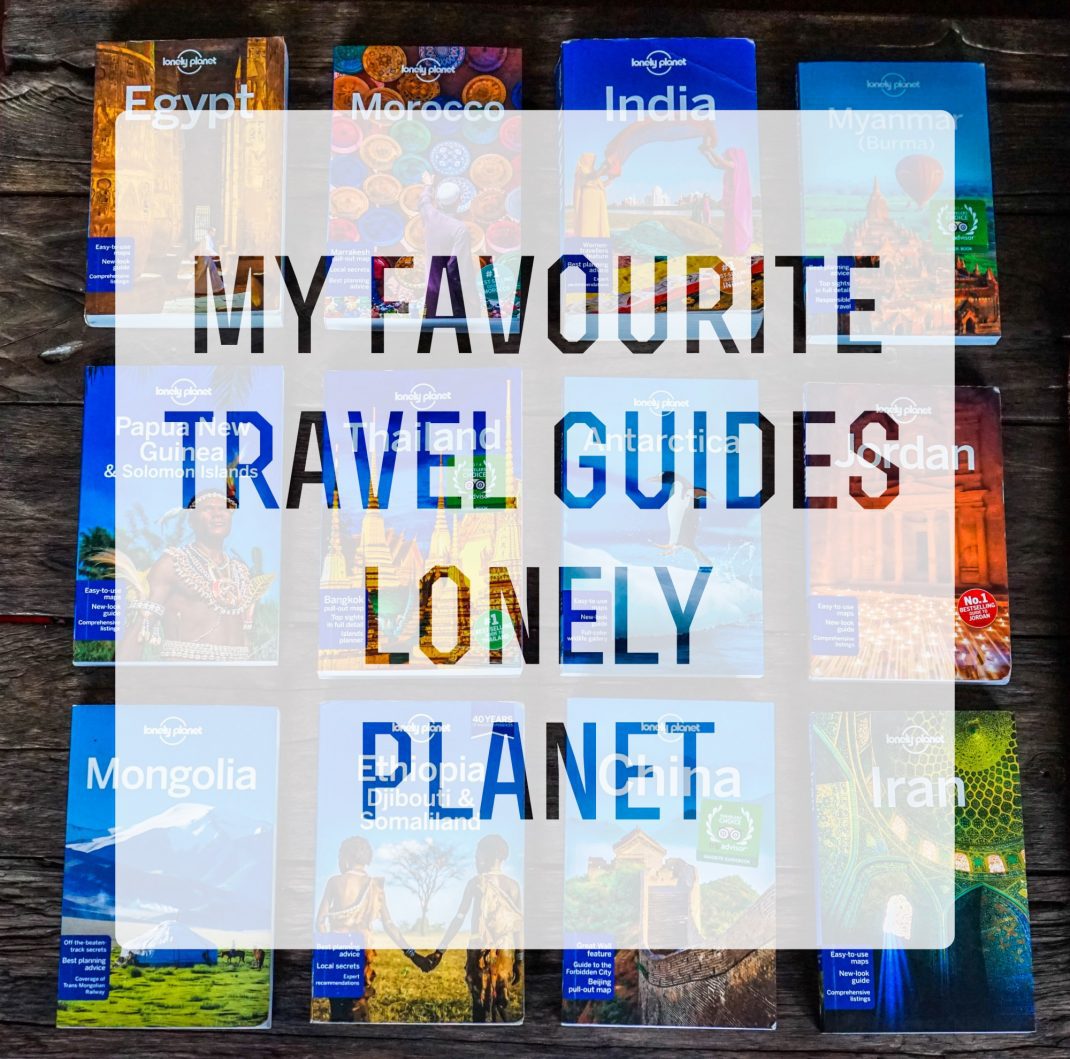
Why I love Lonely Planet Guides
The Variety – Name the country and there is most likely a Lonely Planet for that place and if you look further there are probably- City guides, Region guides, and picture guides to get you inspired and excited about your next trip abroad. I had even used the Lonely Planet for when I was traveling in Libya, Pakistan and Afghanistan. They truly do have everywhere.
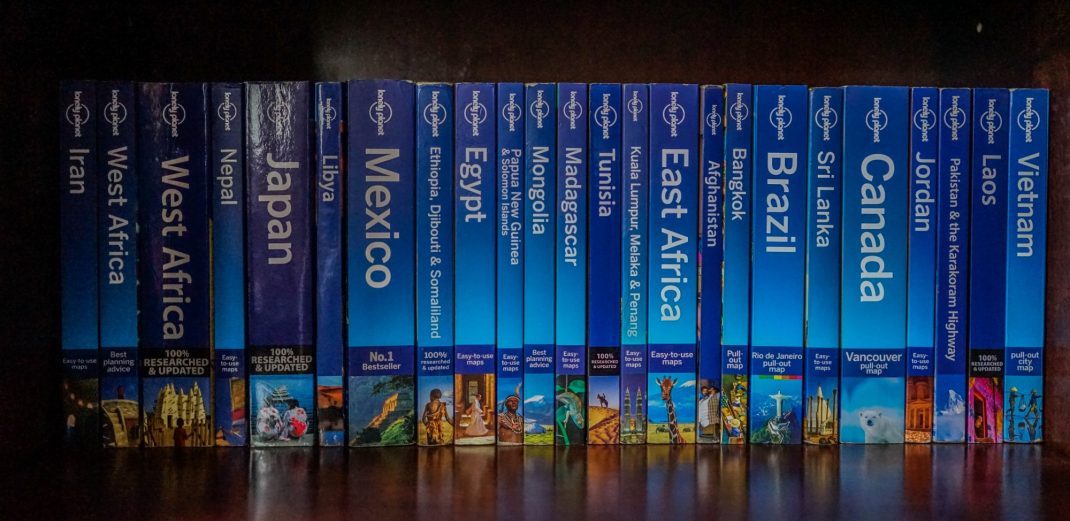
Maps – Lonely Planet’s maps are nothing less than incredible. They are highly detailed and very large. They pinpoint hostels, restaurants, sights, transport and the list goes on and on. I cannot imagine being anywhere without a map and Lonely Planet offers a map for every city, town and region for your specific country. By far, the best maps in any guide book I have picked up.
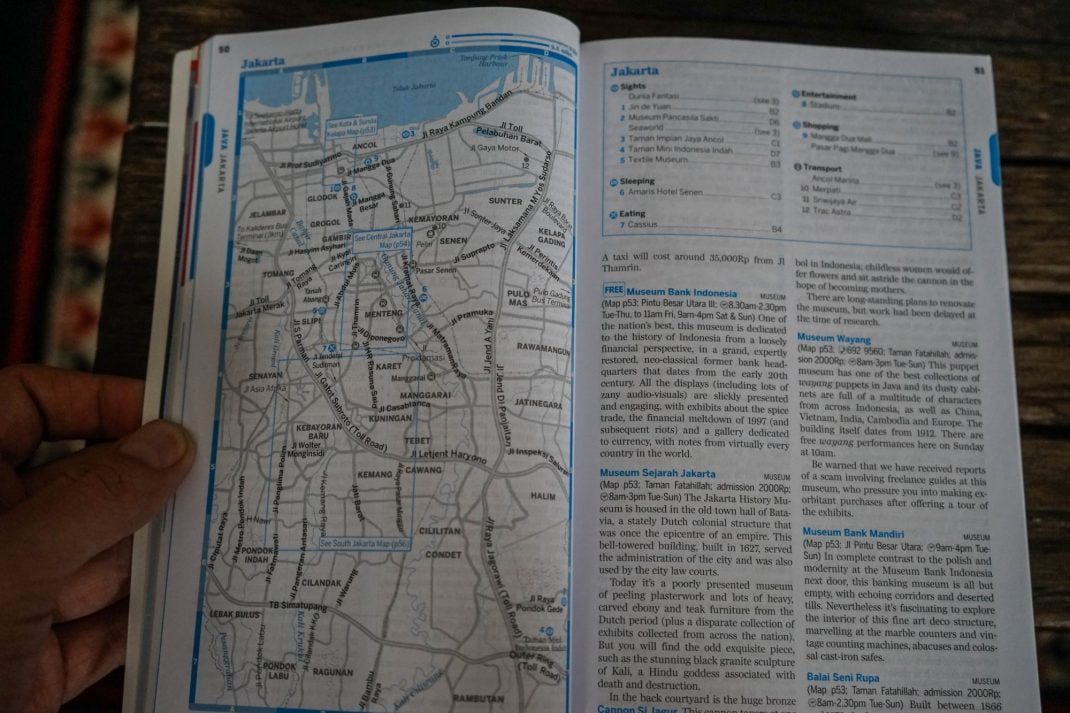
Updates – Lonely planet often updates each guide every few years and some more than once in a year. You really never have to worry about having out of date information; just check when the latest copy is and when the next is coming out.
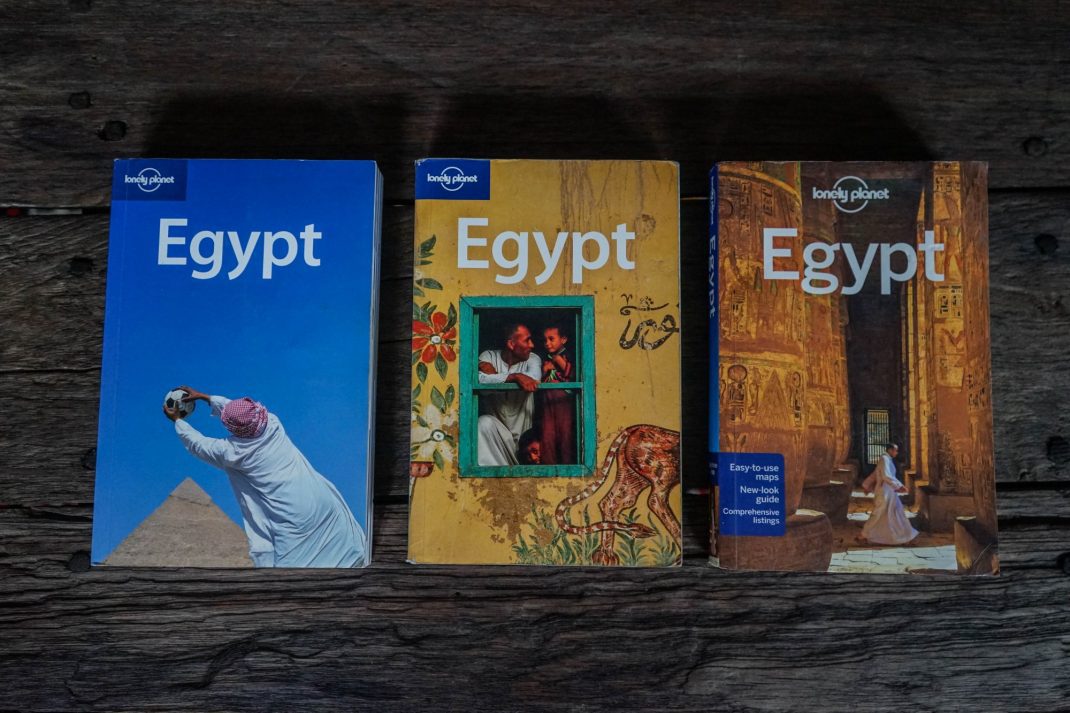
In Depth – These guide books are packed with so much information that you should start reading long before your trip begins. There are chapters about history, culture and many incredibly useful travel tips. These books even go as far as having the exact times tables for public transport. They even had a location for where the bus ticket man was in Mazar Sharif in Northern Afghanistan, trust me I would not have found him without the information.
Pictures – Lonely Planet has come a long ways with their photos in the past few years. They now accept photos from anyone making these guide books photos developed by travelers just like me and you. Open the front of any Lonely Planet and you will instantly be inspired from page after page of beautiful photos ranging from architecture to locals living their day to day life.
How to use the Lonely Planet guides
Step 1 – Get Inspired Think of a country that calls deeply to you, next find that lonely planet and open the front to the Lonely Planet Highlights map. Read the Highlights and get even more excited than before but also learn more about why you want to go to this particular country. Next browse through the photos and see the amazing sights this country has to offer.
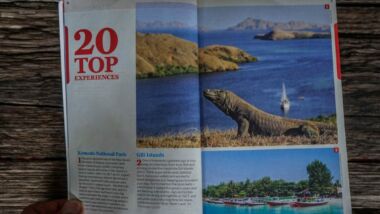
Step 2 – Need to know and trip itineraries Next is the need to know section, this covers the seasons for when you plan to travel, currencies, budget, and valuable visa information. Right after you understand when traveling here will best work for you move onto the itineraries. Now remember nobody follows the time and exact trail of these itineraries, but they give a valuable insight on how to travel certain routes and whether a bus, plane or boat might be the best option. The time frame they give can also be useful although you can definitely go at your own pace.
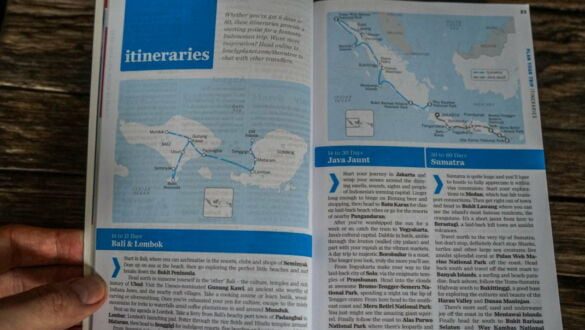
Step 3 – The plan Now that you have a route and been inspired by pictures look deep into the guide; flip to each location you have chosen and read about how to get there, the sights in that city or region and if there are any other sights around there that might interest you. After you have done this you can start to build a time frame of how long this trip will take. It also will give you a perspective of how much money each location will cost, for example many people are surprised in Ethiopia (a country known for how cheap it is) how Lalibela costs 50 US dollars! But after reviewing each region there will be no surprises when you arrive in each destination. Each destination chapter features the highlights within that region or city as well, here you can find more and more sights that will make you jump with excitement and call your boss to extend your holidays.
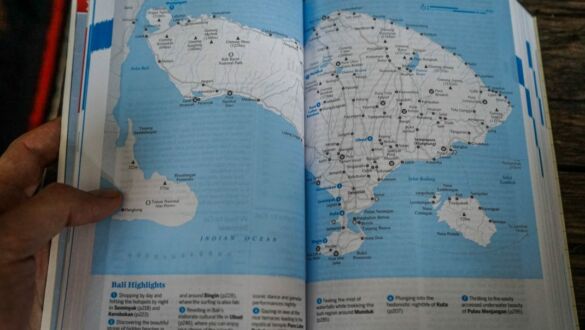
Step 4 – Advanced booking Now that your trip is planned you can start booking and calling ahead to anything that might take advanced booking. For example in Japan if you are going to book the Japan Rail Pass you will read that you must book it before you arrive in Japan, valuable information like this can be found in the back of the book chapter named Transportation. Also Lonely Planet gives websites and hotel phone numbers for booking ahead, a good idea for countries like Thailand where in the high season everything is booked up.
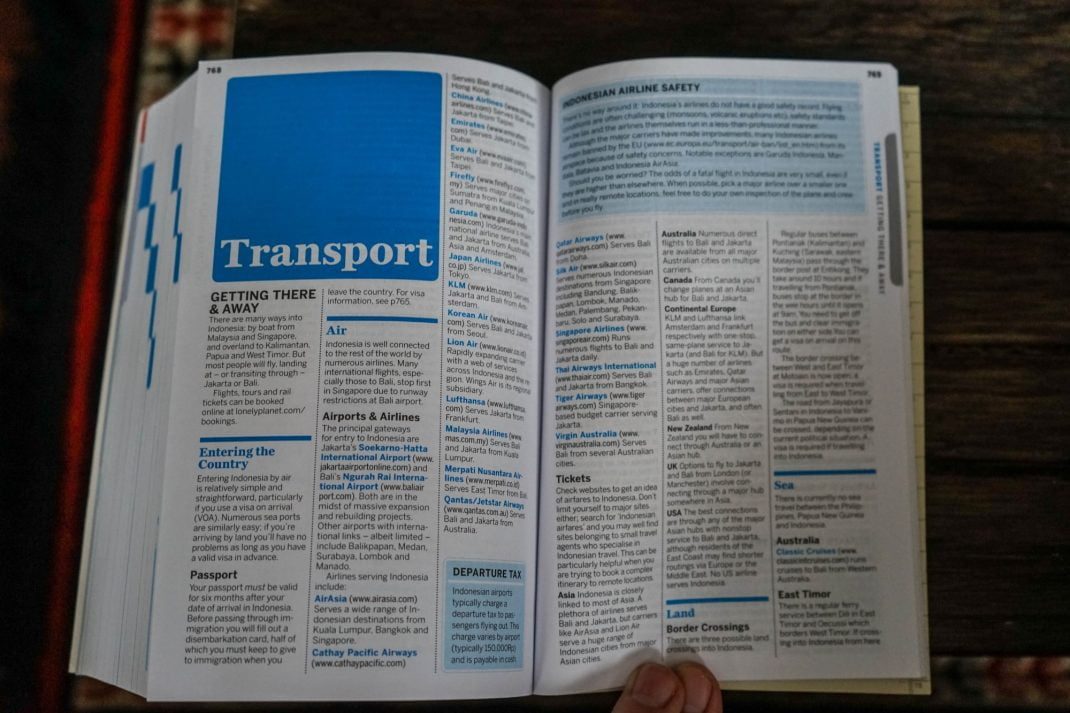
Step 5 – History, culture, food Everything is ready, trip planned, hotels and transport booked and inspired by Lonely Planet’s photos, what’s next? Lonely Planet has in depth chapters on the History, Culture and Food, these chapters will give you a good insight on local customs do’s and don’ts while eating and being invited to someone’s home. Also what to expect your host to serve you at your dinner table. The Culture and History chapter will teach you about the past and present event of your chosen country and even the music or dance the people love so that you can keep up with conversation at the dinner table.
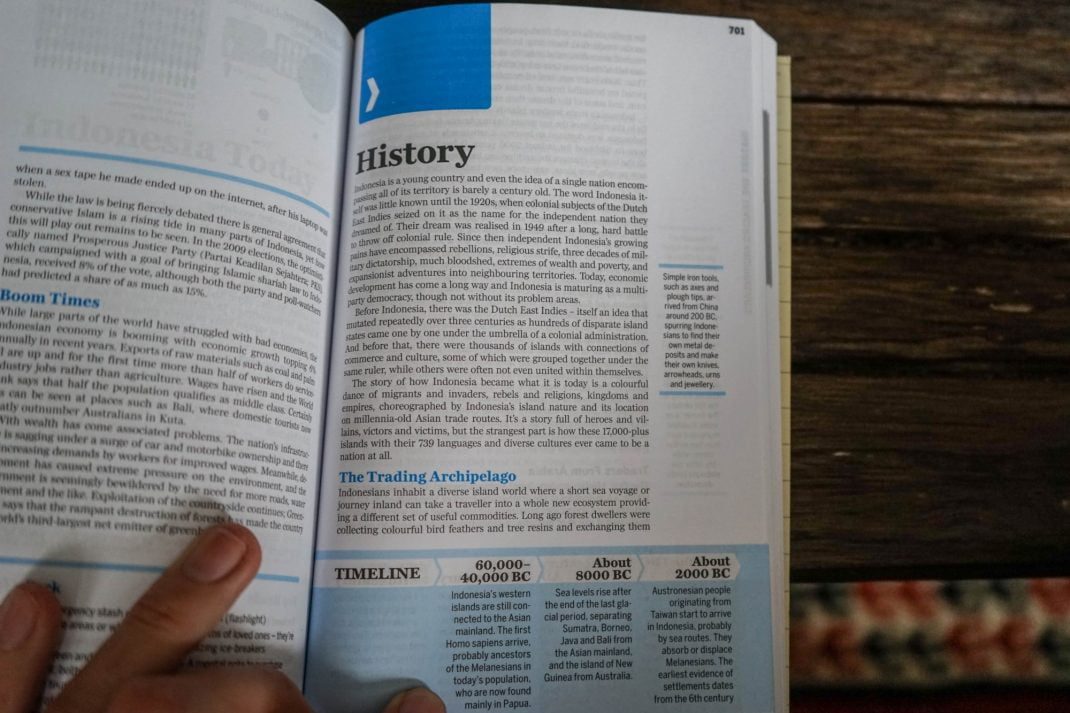
Step 6 – Language Being a buff on the local History and Culture is great but now you need to impress the locals with a word or two in their language. Lonely planet books offer a small chapter in the back designated for just this; they even go as far as breaking the words down into more similar version for us English natives to understand.
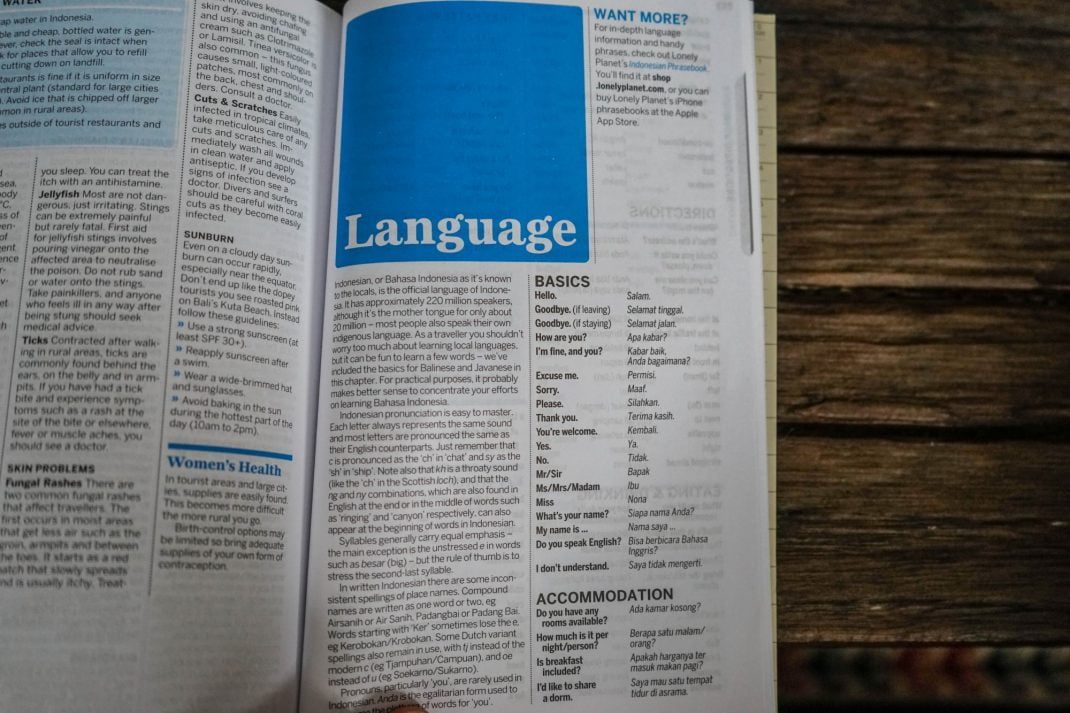
At this point you should have a better understanding of how the Lonely Planet guide book works. It is valid to keep an open mind as things may change in the life time of your current version, but you will definitely feel more confident to step on that plane and go. Unfortunately you will not fully understand why it is so valuable until you are faced with obstacles while traveling. These obstacles however will be no problem because you have brushed up on your knowledge of the country with Lonely Planet and have your copy ready with the answer to any problem. After your first trip you too will become just as addicted to these wonderful guide books and use them to fight the travel blue (period of time in between trips).
Buy your Lonely Planet books HERE to support the blog!
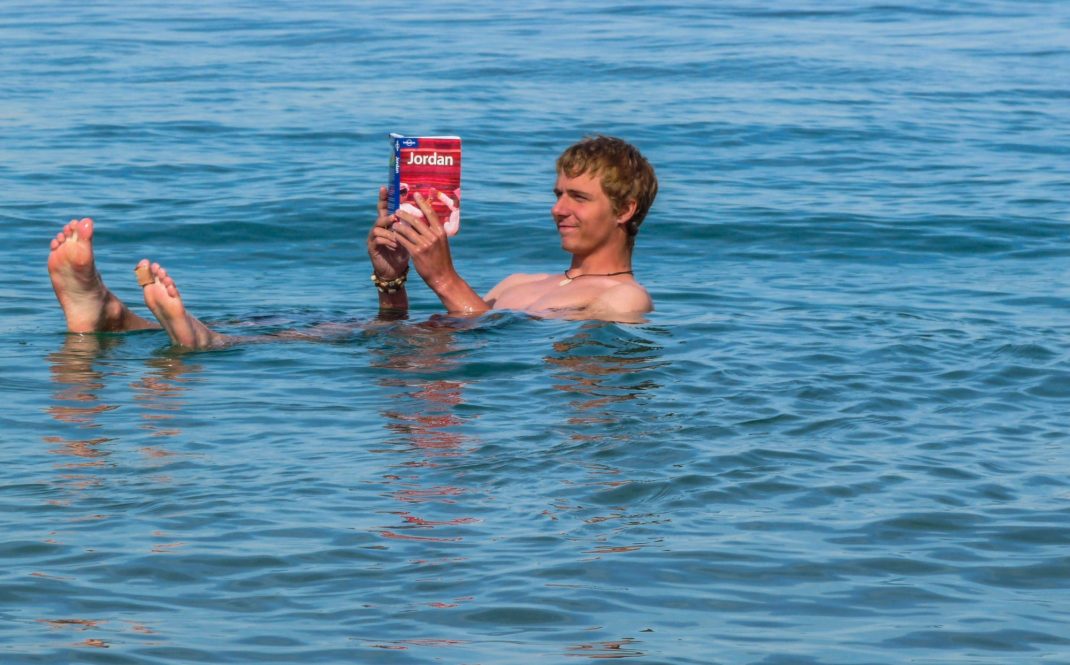
Stephen Gollan
Uncharted Backpacker is a glimpse at the past eleven years of globetrotting I have done. Now at over ninety countries I share my travel knowledge for you so you too can travel the world and see what wonders it has to offer.
Related posts
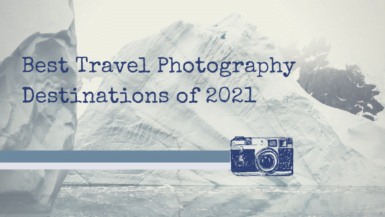
Best Countries For Travel Photography 2021
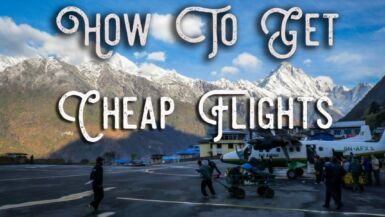

How to Get Cheap Flights!
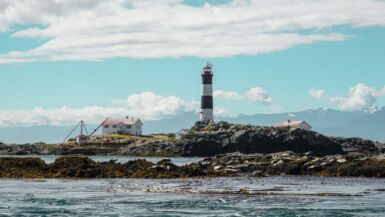
A Travellers Guide to Victoria, Canada
Leave a reply cancel reply.
Your email address will not be published. Required fields are marked *
This is a lot of traveling and thanks for educating and advising others. You see things few people could ever dream of seeing and knowing .Keep up the good work and be safe.
Id have to disagree Lonely Planet has gone way downhill in a past few years. The maps are much less quality than the old books. They just cant compete with online information. For current better print media guides Bradt for practical information and Insight Guides for planning are superior. Lonely planet old guides for reference can be found in torrent where u can get every book in pdf free
Hmm interesting! thanks for the Comment!
I have recently stayed at the Quality Hotel in Antwerp, Belgium, although I have forgotten the address. I found it very good value for money. My room was spacious, the bed comfortable. At 15 euros the breakfast was slightly expensive. The hotel itself is conveniently placed in the city centre,about a 20 minute walk from the train station, though at the time of writing, you have to pass some roadworks that looks like will be there for quite some time yet.

What’s the Matter With Lonely Planet?
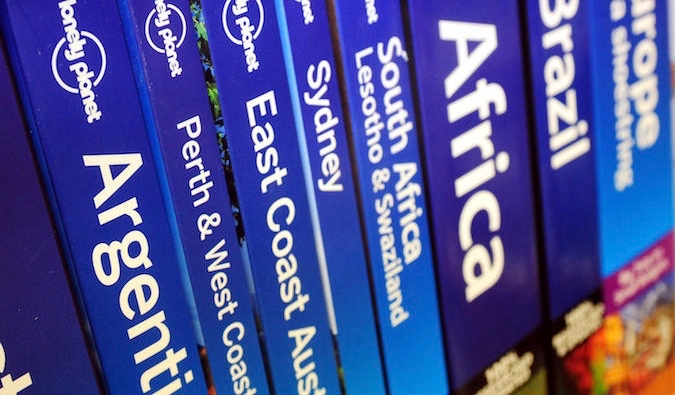
When I decided to quit my job and travel the world , I walked into a bookstore and bought Lonely Planet’s Southeast Asia on a Shoestring . I was in Thailand and was eager to get started. Buying that guidebook made my impulsive decision seem real. Thumbing through its pages on my flight home, I was hooked. I loved its emphasis on budget travel and backpacking, the offbeat destinations, and its quirky and funny writing. As I planned my trip, LP’s “shoestring” guides were stacked high on my desk — and I became a permanent customer of Lonely Planet guides. Their personality matched mine and I was hooked.
Dubbed “the backpacker’s blue bible,” Lonely Planet’s guidebooks focused on unique destinations and budget travel, which made them a staple of travelers worldwide. For good or ill, Lonely Planet often made destinations, hostels, and restaurants.
Sure, its guides became synonymous with mass tourism, but for me, they were a great resource to thumb over while on a bus or train, or in a hostel. I navigated with LP maps and used LP guides for basic activity information and to figure out transportation.
But, lately, their quality seems to have gone down a lot. The last couple of times I’ve used their website and guides ended in frustration and disappointment and made me ask myself:
“What the heck is the matter with Lonely Planet?”
Is Lonely Planet still even good or relevant?
While it’s still the largest guidebook company in the world with 25% of the market, it’s fallen from its perch as “the bible” for budget travelers. After being sold to BBC in 2007 and then sold again to a reclusive billionaire named Brad Kelley in 2013, Lonely Planet is a shell of what it used to be. Kelley hired a 25-year-old photographer named Daniel Houghton, who came on board and “ invested heavily in a digital revamp and laid off nearly one-fifth of the workforce. ”
To further quote that Outside article, “I [the author] ask what the market research says about all that. ‘I didn’t really look at it,’ [Houghton] says, lowering his voice conspiratorially. ‘I don’t really go with market research. I kinda go with my gut.’”
And that’s where much of the blame lies.
What the market really says
As I sat down to write this article, I asked readers on social media what they thought of Lonely Planet. While most people still used Lonely Planet (and guidebooks in general) for preplanning, they reiterated what I kept hearing on the road: the books seem to get more out of date, the writing has lost its edge, the guides have gotten more upscale and less about offbeat and budget destinations, the website is hard to use, and blogs are often better. Here’s some examples of common responses ( click here to see them all ):

Over the years, travelers I’ve met in person have echoed the same complaint: that LP’s special je ne sais quoi is long gone. In fact, I’ve had some good bonding sessions over the topic!
Clearly, the market has a different opinion about the guides than management. Travelers, while still using the guide, don’t like it as much. I still see people using guidebooks on the road so the problem isn’t that people don’t use guidebooks.
The problem is Lonely Planet itself.
Last year, the CEO was interviewed in Amuse and talked about how he was making LP an uncurated (my word) travel content company: “We’ve never looked at Lonely Planet just as a book company, or a guidebook publisher — in fact my first interaction with Lonely Planet actually was on our website, probably when I was in college — we’ve always looked at it as a content company.”
But guidebooks are not content companies, they are curated resources from experts. We buy them because we don’t want a TripAdvisor or a generic source of information — we want someone who has been there and done that to help us do the same. Whether app, e-book, or paperback, consumers want a trusted source of information. We want someone to cut through the noise for us. If LP is just another generic content company that lists every thing and exists to generate ad revenue, then what makes them unique? Are they just a bigger version Condé Nast Traveler or Afar ?
It’s true Lonely Planet had problems long before the current management. Tony and Maureen Wheeler, the company’s founders, will be to the first to tell you they failed in the digital space. This is part of the reason they sold LP to the BBC. The BBC in turn just didn’t do much with the company and let Thorn Tree — LP’s forum and the best part of the site — struggle, as there were many mishaps and closings, as well as poor management.
Yet that was in 2013. The current problems are owned by the current management. Their desire to turn Lonely Planet into a content company is a terrible decision that is out of touch with what travelers want.
A rapid decline in quality
The decision to ignore market research and go with their gut explains much of the decline and why the books are a shell of what they used to be. When the company was last bought, most of the old execs were fired, bought out, or driven out. In their place was installed a management team with little knowledge of the industry they were now in.
Multiple sources reached out to me for this article to describe their experiences with Lonely Planet since the buyout. Authors complained about LP’s lack of communication, respect, and input, and about policy changes that communicated to their contributing experts “please go away.”
It’s something I’ve been hearing for years from my LP friends. (When you’re a travel writer, many of your travel-writing friends will be LP writers.)
I’ve long heard rumors and whispers about LP’s recycled content and desk updates (i.e., information written in the office, not from research at the destination), and that seemed to be corroborated by current employees. Often, I’ve heard, Lonely Planet contributors are told to use Google and TripAdvisor to create content.
LP has this giant content management system, where the author submits their research and, from that, they make the guidebook. But I’ve been told that now, after writers enter information into the database, another person — who may have no knowledge of the destination — comes along and assembles a book. So, in the end, you get this disorganized — and often wrong — book.
Because of these changes, writers seem to have developed a disdain for the company and merely deliver what’s “just good enough.” They aren’t paid a lot, work under tighter and tighter deadlines, and don’t feel part of the company anymore.
How much of this is “sour grapes,” I don’t know, but I’ve heard this complaint for enough years by enough sources that I believe it. I don’t blame the writers. I’ve seen my friends on assignment. They have a lot to do and little time to do it in – plus, the pay is terrible. So, it’s no surprise that if you treat the content creators poorly, you’re going to get poor content.
I – and many others – see that reflected in the quality of the guides.
A terrible website
And this decline can be very clearly seen on the LP website. After Houghton first took over, the website looked like this:
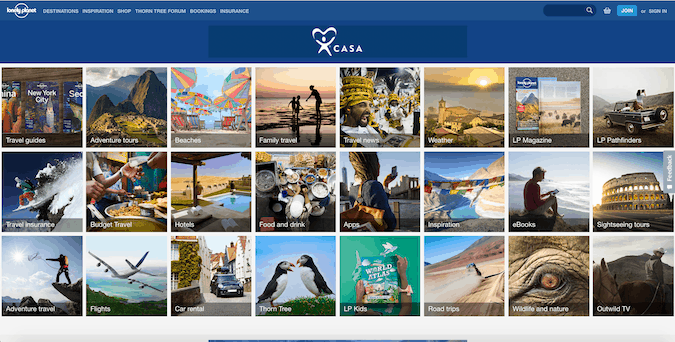
I mean, what is this? It’s a bunch of squares (for ants!*). Who thought this was good? It would take me ages to find the square I needed. Often I gave up and simply found a blog instead.
Now, while I like many things about the new Lonely Planet website — the larger pictures and bigger font — the content sections are hard to follow, and navigating the website is just as difficult as ever. I was trying to find information when I was in Lyon recently — and it was just scrolling and scrolling and scrolling. Why? They list like every place in the city – every church, attraction, park, or restaurant. (They do it for all their destinations.) I don’t want every restaurant or attraction — I want guidebooks and experts to give me the best . Distill the information down for me! If I wanted an endless list, I’d go to TripAdvisor or Yelp!
Plus, the information is so hard to find now. Here’s an example of LP’s California page in 2010 and now:
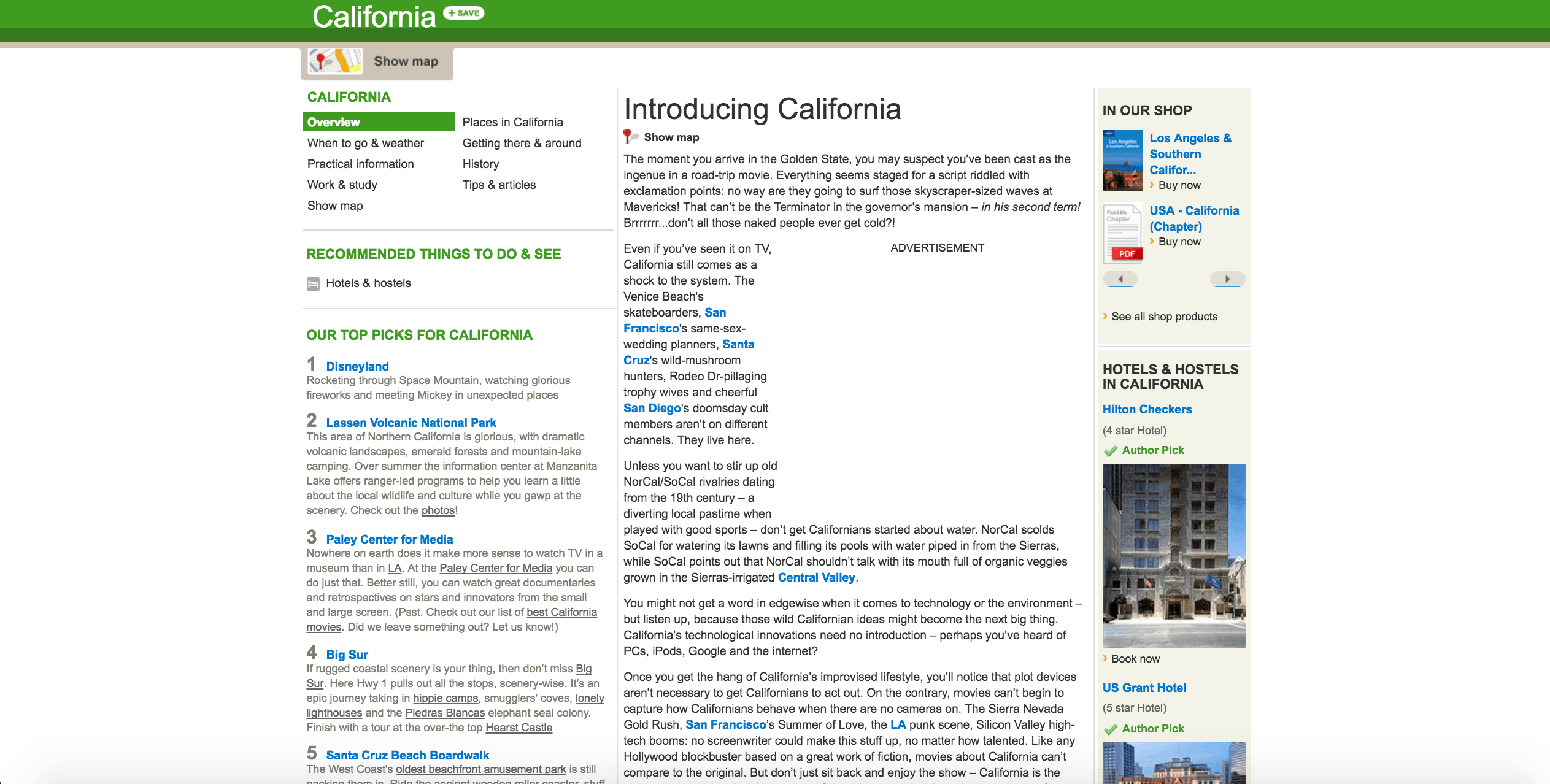
(Well, the page is so long and empty that I can’t take an accurate screenshot so here’s a link to see for yourself .)
In the old version, all the essential information is on the page (and if you go to the link for the page, you’ll see that essential information is just below the fold ). It was easy to get to where you wanted to go, there were no endless lists, and they gave you the facts you needed. It had what you wanted. In the new version, you scroll, scroll, and keep scrolling. There’s a lot of space, not a lot of curated information, and it’s really hard to find what you are looking for.
It’s not just the California page. One just has to go to Paris to find that Lonely Planet’s “top list” is never-ending. And the descriptions of attractions, restaurants, and bars are even less useful than what Google or Yelp offers. Here’s a description of the Prescription Cocktail Club in Paris (one of my favorites):
With bowler and flat-top hats as lampshades and a 1930s speakeasy New York air to the place, this cocktail club — run by the same mega-successful team as Experimental Cocktail Club (ECC) — is very Parisian-cool. Getting past the doorman can be tough, but once in, it’s friendliness and old-fashioned cocktails all round.
That basic information doesn’t really tell me much about the décor, ambiance, or incredible drinks: the cucumber water you get when you sit down, exposed brick walls and dark wood bar, the jazz music, or the inventive cocktails. (Also, there’s no doorman. That’s simply wrong.) I’d take a Yelp review over the above any day.
When I was searching for things to do in Lyon, it was so difficult to find basic information (again, it’s just endless lists) and suggestions that I just gave up and consulted Yelp and blogs. These sites were better organized, gave me a curated list of places, and provided more detailed descriptions.
So what is the matter with Lonely Planet?
LP’s desire to be a “content company” is clear: the increased articles on the site that seem to exist to only drive page views, the sponsored content from the places (and companies) it reviews, the funneling of people from content to booking sites, the TripAdvisor–style listing of everything ( more page views), and the plethora of ads that now litter the site. Additionally, the heavy emphasis on selling tours to destinations seems to go against the grain of independent travel that the company was founded on. You can tell the company has changed simply by what they focus their online content on.
We consumers visit travel blogs and use guidebooks because we want an expert to tell them what’s best. We want someone to distill it all down for them so we don’t have to do the work. It’s why we carry LP guides and not Condé Nast Traveler or Outside magazines on the road. Those are great for inspiration, but not on-the-ground information.
By losing that focus, trying (in my opinion) to appeal to everyone, and attempting to compete with sites like TripAdvisor (and even blogs to an extent), LP has lost what made it great.
I believe companies are better off when they have one thing they focus on. Andrew Carnegie once said, “ ‘Don’t put all your eggs in one basket’ is all wrong. I tell you, ‘Put all your eggs in one basket, and then watch that basket.’ ”
Lonely Planet should be a guidebook company. Being a guidebook company doesn’t mean you have to focus on physical books, but it means you focus on your one thing. Its shift from its singular mission to becoming a “digital content hub” means that it’s no longer unique — and when you are no longer unique, consumers have no reason to stay loyal. As Simon Sinek once said, “People don’t buy what you do, they buy why you do it.”
You used to know what the Lonely Planet brand meant and what they stood for. Now, I don’t know what the company stands for.
LP still is king because of its sheer size. It is the Microsoft of guidebook companies. Not one person I talked to had any loyalty to the brand anymore. They often bought the guides simply because there was no one else selling one to their destination.
I’ve been a loyal LP customer since 2005. Their guidebooks are all over this website. I still buy them. They are often the only game in town to where I want to go. But, lately, I’m not so sure about them anymore. I haven’t given up on them – but I’m getting closer to doing so. It’s hard to watch them morph into something so….forgettable.
So what’s the matter with Lonely Planet?
In short, just about everything.
* Zoolander reference: “What is this? A center for ants!” Ahhh, never gets old!
Update 1/19: Houghton left Lonely Planet in late 2018.
Book Your Trip: Logistical Tips and Tricks
Book Your Flight Find a cheap flight by using Skyscanner . It’s my favorite search engine because it searches websites and airlines around the globe so you always know no stone is being left unturned.
Book Your Accommodation You can book your hostel with Hostelworld . If you want to stay somewhere other than a hostel, use Booking.com as it consistently returns the cheapest rates for guesthouses and hotels.
Don’t Forget Travel Insurance Travel insurance will protect you against illness, injury, theft, and cancellations. It’s comprehensive protection in case anything goes wrong. I never go on a trip without it as I’ve had to use it many times in the past. My favorite companies that offer the best service and value are:
- SafetyWing (best for everyone)
- InsureMyTrip (for those 70 and over)
- Medjet (for additional evacuation coverage)
Want to Travel for Free? Travel credit cards allow you to earn points that can be redeemed for free flights and accommodation — all without any extra spending. Check out my guide to picking the right card and my current favorites to get started and see the latest best deals.
Need Help Finding Activities for Your Trip? Get Your Guide is a huge online marketplace where you can find cool walking tours, fun excursions, skip-the-line tickets, private guides, and more.
Got a comment on this article? Join the conversation on Facebook , Instagram , or Twitter and share your thoughts!
Disclosure: Please note that some of the links above may be affiliate links, and at no additional cost to you, I earn a commission if you make a purchase. I recommend only products and companies I use and the income goes to keeping the site community supported and ad free.
Related Posts

GET YOUR FREE TRAVEL STARTER KIT
Enter your email and get planning cheatsheets including a step by step checklist, packing list, tips cheat sheet, and more so you can plan like a pro!


5 big travel lessons and one ‘mistake’ from 50 years of Lonely Planet
Tony Wheeler has spent half a century traversing the globe but still carries a guidebook. Naturally, it’s his own.
“Just a couple days ago in Brazil, I went to Iguazu Falls,” Wheeler, 76, said during a recent video call from a hotel guest room in New York City . “I went across to Argentina and had the Lonely Planet guidebook. It said to take the walk close to the river level because everybody heads to the top one. You know, the guidebook got it right.”
Wheeler and his wife, Maureen, founded Lonely Planet guidebooks 50 years ago. In 1972, the newly married couple bought a ratty old car in London and drove east, across Europe, and then farther east, to Turkey, Iran and Afghanistan, where they sold their vehicle. In Australia, their final stop, one adventure ended and another began.
Their first publication, “Across Asia on the Cheap,” spawned more than 150 million guidebooks covering 221 countries. It also heralded a new generation of travelers who were young, adventurous and scrappy. Like true rebels, they ventured where few parents had gone before.
“These were books for people in their 20s with no money,” he said. “If their parents had gone to Europe, they were going to Asia. If they were in Europe, they were going down to Spain and across to Morocco. Instead of escaping the States to Mexico, they’d go down to South America. Their horizons were getting larger, wider.”
In 2011, the Wheelers, who split their time between London and Melbourne, Australia, sold their publishing company. Red Ventures, which also owns the Points Guy , took over in 2020. Although they are no longer actively involved in the series and have upgraded their travel style, they still embody the spirit of the “ backpacker’s bible.”
The day after Tony returned from South America, he shared some of the lessons he has learned from his 50 spins around the Lonely Planet.
1. Always carry on
Mishaps happen to even the most seasoned traveler, and you just have to roll with it.
During his recent trip in Brazil, the airline repeatedly canceled his flight to New York. He spent four hours standing in line at the airport counter trying to sort it out. “You can fly across the Atlantic in the Concorde in that amount of time and have a meal, as well,” he said dryly.
Also this year, an incident in France forced the railway to shut down its entire line. Then a torrential rainstorm hit. “I was standing around on a platform with rain pouring down for four hours,” he said.
Wheeler gamely acknowledged that a traveler’s best material often comes from plans that went awry.
“People like to hear the bad stuff,” he said. “No one wants to hear that my flight left on time, my seat was the one I wanted, I liked the meal and my baggage turned up.”
Speaking of lost luggage, he avoids it by limiting himself to carry-on . He said an opera singer friend would have significantly reduced her stress level had she followed suit. On her flight from Munich to his London home, the airline lost her bags. Several days later, a delivery man drove up in a vehicle packed with hundreds of pieces of luggage waiting to be reunited with their owners.
2. Travel for the people, not the politics
Of all the travel guides, Wheeler said Burma caused them the most angst. At the time, people were urged to boycott the country to avoid indirectly aiding the brutal military regime. After several research trips, the couple decided to publish the book in 1979, but encouraged travelers to support local businesses and not government-owned ones.
“The locals really wanted the tourists, and it wasn’t just for the money,” Wheeler said. “It was for the communication with the outside world.”
Wheeler is similarly conflicted by Iran. “The government’s awful, but the people are wonderful,” he said. To illustrate this point, he described the heartwarming interactions he repeatedly experienced in restaurants. Diners would notice that he was eating alone and spoke English and would invite him to join them at their table.
“How often does that happen in a restaurant in England or America?” he said. “In Iran, that does happen and I think it’s kind of amazing.”
The eighth edition of “Lonely Planet Iran” is scheduled for released next December, an update to the 2017 version.
3. Trust your research and instincts
On the subject of crime, Wheeler has been fortunate: He has been a victim only once, when he was mugged in Bogotá, Colombia. He said travelers should thoroughly research a destination but also trust their instincts.
“Things are not always as unsafe as you fear they are,” he said. “Once you get to a place and are out in the streets, you will feel if it is okay or not.”
On a family trip in Guatemala City, the Wheelers set out at night in search of food. The streets were empty and unnerving. But the next morning, they discovered an entirely different city — vibrant, lively, safe.
Wheeler has ventured to more than 170 countries, including many that have faced conflict, such as Syria, Libya and Yemen. He does not take safety lightly. He is intrigued by Nigeria — “It’s the center for movies in Africa and has a lot of entrepreneurial activity ” — but is cautious about visiting Africa’s most populous nation because of safety concerns. Many foreign offices, including the State Department, advise travelers against visiting Nigeria.
“You start with the idea that it’s not going to be totally safe,” he said, “but I’d like to see it one day.”
4. Explore ‘two streets over’ from main drag
For countless travelers, Lonely Planet opened the door to unknown or undiscovered places, but some critics say the books worked too well and have led to overcrowding. Wheeler’s solution to overtourism is actually a Lonely Planet tenet. He recommends always going “two streets over” from the main drag for sightseeing as well as shopping, dining and lodging.
“Everyone is in St. Mark’s Square,” he said of Venice. “There are other parts of the city you can go to and find churches that are not crowded with tourists.”
Another option: Skip the popular destination for a lesser-visited city, such as Ravenna, which he described as the opposite of Venice. “It almost felt like it was undertouristed,” he said.
5. Choose a train over plane
This year, Wheeler has traveled by train in a dozen countries. He said his best train experience was on Amtrak ’s Coast Starlight train from Seattle to San Francisco.
“It was a nice train, and there was quite a lot of conversation at the tables in the bar,” he said. “It was what train travel is supposed to be.”
When possible, he chooses more eco-friendly modes of travel. For a return trip from Lugano, Switzerland, he took the slower but greener route home: train from Zurich to Paris, then Eurostar to London. In Uruguay and Paraguay, he relied on trains and buses, which have vastly improved since his last overland adventures.
“My bus travel years in South America was a long time ago,” he said. “It felt dangerous all the time, the buses were uncomfortable and the bus stations were not good places to be.”
This time around, the bus station in Montevideo, Uruguay, was modern and had a great breakfast spot. The buses were comfortable and safe. The seats came with belts that people actually wore. There was a toilet onboard.
“It was definitely a real change from 40 years ago,” he said.
6. ‘A 50-year mistake’
The company’s name did not stem from a romantic notion about connecting travelers or making the world a less forlorn place, but instead from a 1971 documentary film called “Mad Dogs and Englishmen.”
Over too much red wine at a Chilean restaurant in Sydney, the Wheelers discussed the film’s song “Space Captain” and the opening lines sung by Joe Cocker: “Once I was traveling across the sky; this lovely planet caught my eye.”
Smitten with the lyrics, Tony suggested calling the series, “Lonely Planet.” Maureen agreed, but pointed out the misheard word. “It’s been a 50-year mistake,” he said.
- Share full article
Advertisement
Supported by
Nicholas Kristof
My Travel Tips for Seeing the World’s Best Places

By Nicholas Kristof
Opinion Columnist
’Tis the season for vacations, so let me make my pitch that the best travel is not lounging at a beach resort but rather journeying into a different world. We all need relaxation at times, but nothing beats the thrill of a trip of discovery and the education that comes with it.
Mark Twain once observed that “travel is fatal to prejudice, bigotry and narrow-mindedness.” In that spirit, I’ve long urged young Americans to take gap years before college or junior years abroad . (One high school reader of such an essay, Spencer Cohen , ended up taking a gap year partly in Japan, became an Asia hand and is now a colleague at The Times.)
Still, there are risks, less of violence (the U.S. has more guns than other countries) than of having your passport and credit cards stolen. So I preach both travel and prudence, and on a recent book tour , I found myself often asked about travel advice I had mentioned in my memoir. So let me share a few tips for the vacation season:
1. The most memorable travel often involves encountering something unfamiliar, so consider escaping the herds parading through Paris. Indonesia, Ghana, India, Nepal, Vietnam, Morocco and Bolivia are generally safe, far cheaper than Europe and offer indelible experiences. I’ll never forget venturing deep into the Potosí silver mines in Bolivia, exploring a grim slave castle in Ghana that dispatched prisoners to slavery in America, learning how to use a blowgun while staying with families in their longhouse in Indonesia’s Borneo rainforest. The world awaits us!
2. Some of the places that you find most culturally distant may be right here in the United States. A teenager from an affluent family in the New York or Boston areas would step into a different world by taking a ranch job in Wyoming. And this is the kind of travel that is not only affordable but actually pays for the experience.
3. Be spontaneous. As a law student in 1982, I spent five weeks backpacking through the Middle East and met a couple of Palestinian students on a West Bank bus; I jumped off at their stop and spent a memorable day with them in their refugee camp hearing about their frustrations and dreams (I wrote about reuniting with them last fall). And while on a bus in the Sahara, I accepted an Algerian man’s invitation to visit his village — which turned out to be a warren of underground burrows to protect families from the extreme heat, the most unusual residential architecture I’ve ever seen. In each case, I was with a couple of friends, which made it seem safer to put myself in the company of people I’d just met, and obviously one should be as judicious as one is spontaneous.
4. One occasionally hears that adventurous travel is just for men, but some of the most accomplished foreign correspondents and overseas photographers are women, as are a majority of Peace Corps volunteers. As a man, I don’t face the same risks that women face, but I have seen female travelers — disproportionately from Australia and New Zealand — thriving as they backpack through the most remote places. Some have suggested the purchase of a cheap wedding ring; a $20 band and a fabricated husband can help keep pests away.
5. Carry a decoy wallet. If pickpockets grab it, let them run off — only to discover that it contains just a bit of cash for street purchases, a day pass for the subway and an expired credit card. But do remember to let the pickpockets escape. Years ago, in Lima, Peru, I instinctively jumped a pickpocket who was trying to grab my friend’s decoy wallet, forgetting that he had nothing much in it; next thing I knew we had a melee and a gun was being fired.
6. Carry your passport and valid credit cards and cash in a pouch that loops on your belt and is tucked inside your pants. Travelers often carry travel pouches round their necks under their shirts, but these are visible and sometimes get stolen. While I’ve had bandits make me take off my shoes and socks while searching for cash, nobody has found my pouch in my pants (I dare mention this only because I assume robbers are not big readers of my column).
7. Carry a small cable lock (those for skis are perfect) to lock your bags together so one doesn’t run off while you’re sleeping in a train or on a bench at the train station.
8. Never check a bag for a flight because then it will get lost. That means packing light and taking quick-dry clothes suitable for washing in a hotel sink. I’m fond of travel clothing from a company called Clothing Arts , and I also rely on ultralight backpacking gear such as a tiny Black Diamond or Petzl headlamp that is invaluable when the power goes out.
9. If you’re getting into a taxi or other car in a location that seems at all dubious, use your phone to photograph the license plate before you get in. The driver may wonder if you’ve texted it to a friend. And women can look for female drivers if they exist.
10. My editor doesn’t want me to say anything that might encourage readers to try something dangerous, so I won’t suggest that there is nothing like the view while riding on the top of a train in Sudan . (That was in my dissolute youth, and today I definitely disapprove of riding on top of trains.)
11. People worry about terrorists, but the most likely serious risk is probably a vehicle accident. Motorcycle taxis common in low-income countries can be perilous, while buses and trains are safer (inside trains only!).
12. Now forget all the fears this article has conjured. Go have fun. Travel should be as enjoyable as it is eye-opening. If you take precautions it will be.
The Times is committed to publishing a diversity of letters to the editor. We’d like to hear what you think about this or any of our articles. Here are some tips . And here’s our email: [email protected] .
Follow the New York Times Opinion section on Facebook , Instagram , TikTok , WhatsApp , X and Threads .
Nicholas Kristof became a columnist for The Times Opinion desk in 2001 and has won two Pulitzer Prizes. His new memoir is “ Chasing Hope: A Reporter's Life .” @ NickKristof

Download the free Kindle app and start reading Kindle books instantly on your smartphone, tablet, or computer - no Kindle device required .
Read instantly on your browser with Kindle for Web.
Using your mobile phone camera - scan the code below and download the Kindle app.

Image Unavailable

- To view this video download Flash Player
Follow the author

Lonely Planet Japan (Travel Guide) Paperback – Folded Map, March 8, 2022
There is a newer edition of this item:.

Lonely Planet’s Japan is your passport to the most relevant, up-to-date advice on what to see and skip, and what hidden discoveries await you. Explore over a thousand temples in old imperial capital Kyoto, relax in one of the onsens scattered across the archipelago, and sample the breadth of Japan’s sublime cuisine; all with your trusted travel companion. Get to the heart of Japan and begin your journey now!
Inside Lonely Planet’s Japan Travel Guide:
Up-to-date information - all businesses were rechecked before publication to ensure they are still open after 2020’s COVID-19 outbreak
NEW top experiences feature - a visually inspiring collection of Japan’s best experiences and where to have them
What's new feature taps into cultural trends and helps you find fresh ideas and cool new areas
Pull-out, passport-size 'Just Landed' card with wi-fi, ATM and transport info - all you need for a smooth journey from airport to hotel
Planning tools for family travellers - where to go, how to save money, plus fun stuff just for kids
Colour maps and images throughout
Highlights and itineraries help you tailor your trip to your personal needs and interests
Insider tips to save time and money and get around like a local, avoiding crowds and trouble spots
Essential info at your fingertips - hours of operation, websites, transit tips, prices
Honest reviews for all budgets - eating, sleeping, sightseeing, going out, shopping, hidden gems that most guidebooks miss
Cultural insights give you a richer, more rewarding travel experience - history, people, music, landscapes, wildlife, cuisine, politics
Over 150 maps
Covers Tokyo, Mt Fuji, The Japan Alps, Honshu, Kyoto, Kansai, Hiroshima, Sapporo, Hokkaido, Shiko-ku, Kyushu and Okinawa
The Perfect Choice: Lonely Planet’s Japan , our most comprehensive guide to Japan, is perfect for both exploring top sights and taking roads less travelled.
Looking for just the highlights? Check out Best of Japan , a handy-sized guide focused on the can't-miss sights for a quick trip.
About Lonely Planet: Lonely Planet is a leading travel media company, providing both inspiring and trustworthy information for every kind of traveller since 1973. Over the past four decades, we've printed over 145 million guidebooks and phrasebooks for 120 languages, and grown a dedicated, passionate global community of travellers. You'll also find our content online, and in mobile apps, videos, 14 languages, armchair and lifestyle books, ebooks, and more, enabling you to explore every day.
'Lonely Planet guides are, quite simply, like no other.' – New York Times
'Lonely Planet. It's on everyone's bookshelves; it's in every traveller's hands. It's on mobile phones. It's on the Internet. It's everywhere, and it's telling entire generations of people how to travel the world.' – Fairfax Media (Australia)
- Print length 928 pages
- Language English
- Publisher Lonely Planet
- Publication date March 8, 2022
- Dimensions 5.1 x 1.5 x 7.75 inches
- ISBN-10 1788683811
- ISBN-13 978-1788683814
- See all details

Customers who bought this item also bought

Editorial Reviews
About the author, product details.
- Publisher : Lonely Planet; 17th edition (March 8, 2022)
- Language : English
- Paperback : 928 pages
- ISBN-10 : 1788683811
- ISBN-13 : 978-1788683814
- Item Weight : 1 pounds
- Dimensions : 5.1 x 1.5 x 7.75 inches
- #31 in General Asia Travel Books
- #59 in General Japan Travel Guides
About the author
Lonely planet.
With over 150 million guidebooks in print, Lonely Planet is a trusted source for any traveler. Since our inception in 1973, we've inspired generations of travelers to discover amazing places and enabled curious travelers to get off the beaten paths to appreciate different cultures and become agents of positive change.
Customer reviews
- 5 star 4 star 3 star 2 star 1 star 5 star 78% 12% 5% 1% 4% 78%
- 5 star 4 star 3 star 2 star 1 star 4 star 78% 12% 5% 1% 4% 12%
- 5 star 4 star 3 star 2 star 1 star 3 star 78% 12% 5% 1% 4% 5%
- 5 star 4 star 3 star 2 star 1 star 2 star 78% 12% 5% 1% 4% 1%
- 5 star 4 star 3 star 2 star 1 star 1 star 78% 12% 5% 1% 4% 4%
Customer Reviews, including Product Star Ratings help customers to learn more about the product and decide whether it is the right product for them.
To calculate the overall star rating and percentage breakdown by star, we don’t use a simple average. Instead, our system considers things like how recent a review is and if the reviewer bought the item on Amazon. It also analyzed reviews to verify trustworthiness.
Customers say
Customers find the book informative and amazing. They also say it highlights the best places to visit in Japan. However, some customers find the setting overloaded and overwhelming, while others say it's disappointing.
AI-generated from the text of customer reviews
Customers find the book informative, detailed, and helpful. They also say the information is accurate and contains everything they can google.
" Great tool to help us plan !" Read more
"This is a very nice travel guide that is packed with information ; however, after comparing both the Lonely Planet and the DK Japan travel guides, I..." Read more
" Excellent travel reference guide and looking forward to using it on my trip to Japan during this coming holidays." Read more
" Informative & updated book. Good valuable information." Read more
Customers have mixed opinions about the setting. Some find the book perfectly highlights the best places to visit, big and small, while others say it's overloaded and overwhelming.
"...This book is well organized and has a lot of locations to look at . Would recommend as a travel guide." Read more
"...book results in being too thick yet, paradoxically, surprisingly devoid of depth or substance ...." Read more
"...It does look rather comprehensive from the flip through. Will see how the recipient likes it." Read more
"...claims book is "up to date" but in fact is out of date and will waste your time and money ...." Read more
Reviews with images

- Sort reviews by Top reviews Most recent Top reviews
Top reviews from the United States
There was a problem filtering reviews right now. please try again later..
Top reviews from other countries
- Amazon Newsletter
- About Amazon
- Accessibility
- Sustainability
- Press Center
- Investor Relations
- Amazon Devices
- Amazon Science
- Sell on Amazon
- Sell apps on Amazon
- Supply to Amazon
- Protect & Build Your Brand
- Become an Affiliate
- Become a Delivery Driver
- Start a Package Delivery Business
- Advertise Your Products
- Self-Publish with Us
- Become an Amazon Hub Partner
- › See More Ways to Make Money
- Amazon Visa
- Amazon Store Card
- Amazon Secured Card
- Amazon Business Card
- Shop with Points
- Credit Card Marketplace
- Reload Your Balance
- Amazon Currency Converter
- Your Account
- Your Orders
- Shipping Rates & Policies
- Amazon Prime
- Returns & Replacements
- Manage Your Content and Devices
- Recalls and Product Safety Alerts
- Registry & Gift List
- Conditions of Use
- Privacy Notice
- Consumer Health Data Privacy Disclosure
- Your Ads Privacy Choices
- Free shipping on all orders

- North America
- South America
- Middle East
- Australia & Pacific
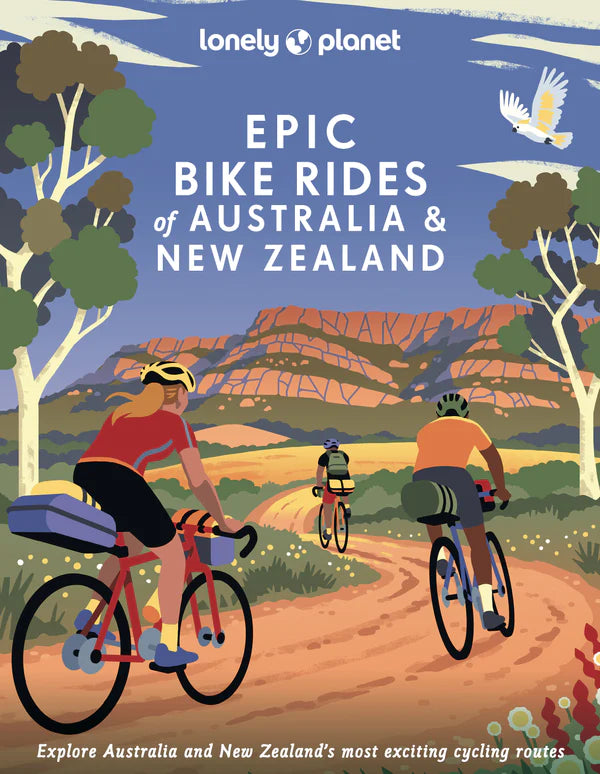
New Releases
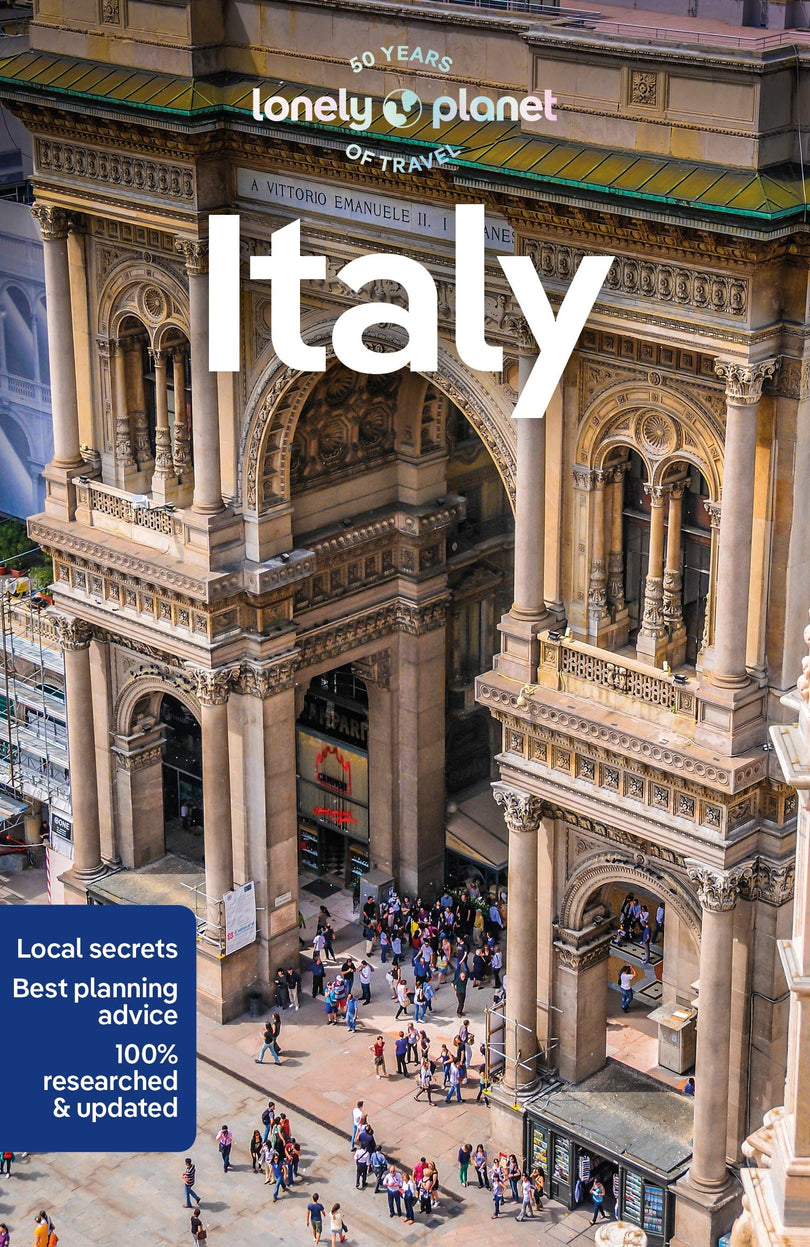
Trending Destinations
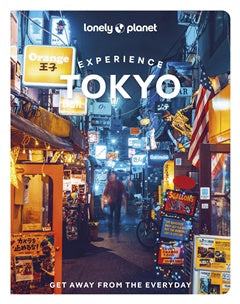
Experience Guides
- Outdoor Travels & Adventures
- Epic Guides
- Food & Drink
- Gifts & Inspiration
- Language Guides
- Lonely Planet Kids
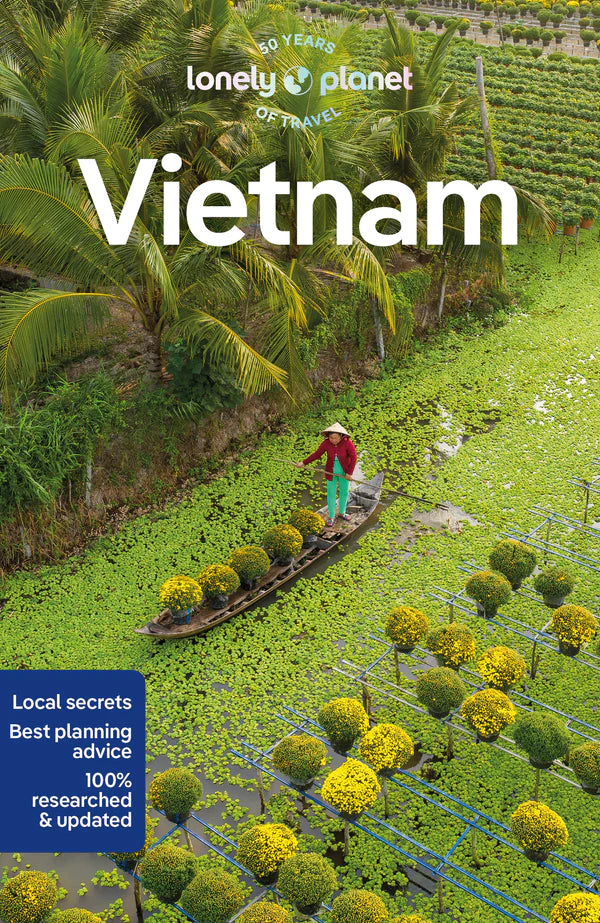
Country Guides
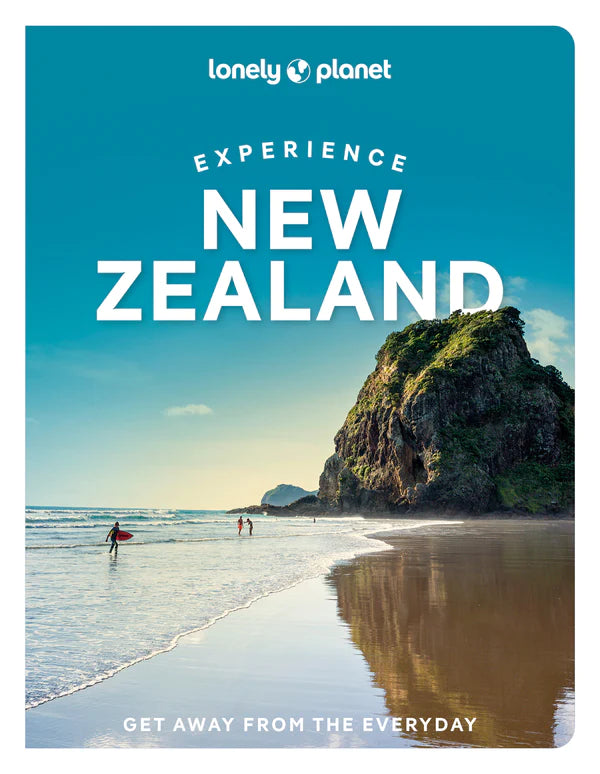
Pocket Guides
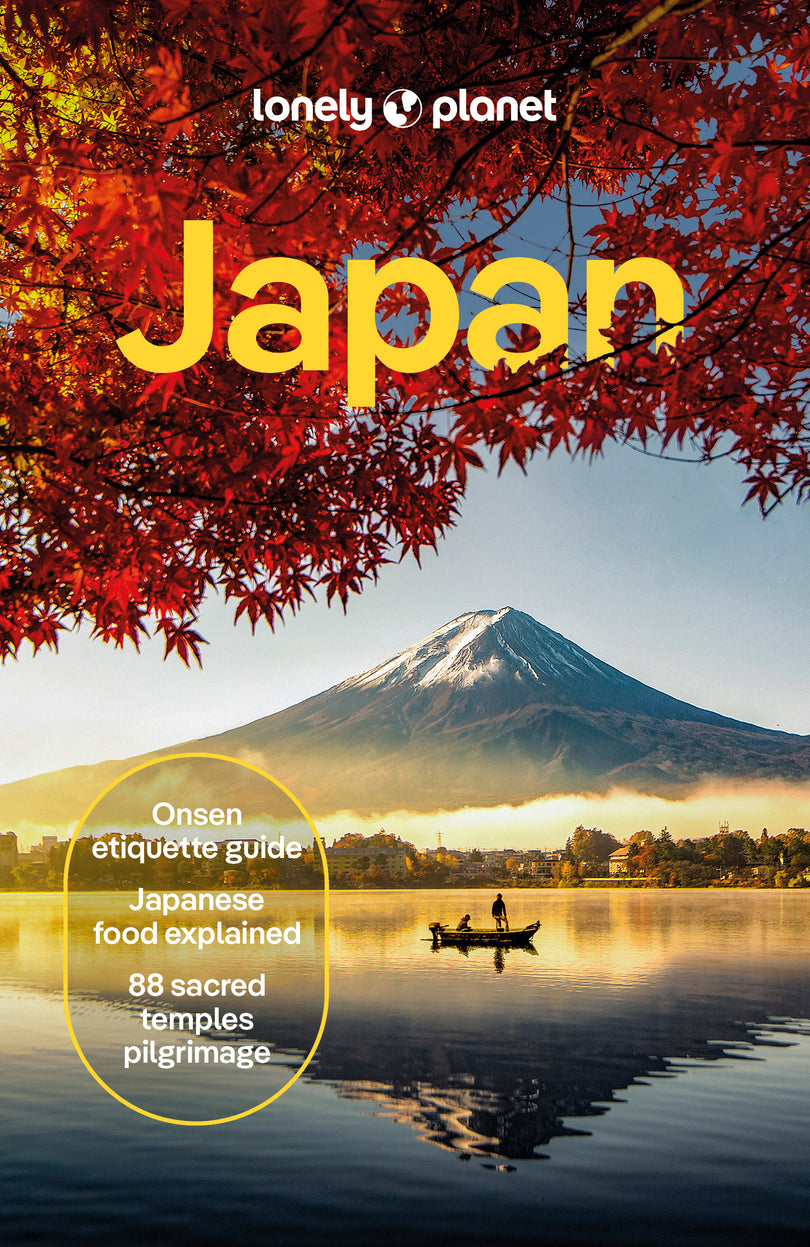
All Guides & eBooks
- Lonely Planet Insider
Your cart is empty
Get this book for free by becoming a Lonely Planet Insider:
- 3 eBook downloads every year
- Exclusive offers and discounts
$2.99 USD/month (charged annually) Learn more
The eBook is only available in PDF at this time.
Lonely Planet's local travel experts reveal all you need to know to plan the trip of a lifetime to Canada.
Discover popular and off the beaten track experiences from visiting Banff - the world's third-oldest national park - to making a poutine pilgrimage to Quebec City to try Canada's most famous dish, and spotting black bears and grizzlies in the Bella Coola Valley.
Build a trip to remember with Lonely Planet's Canada travel guide:
- Our classic guidebook format provides you with the most comprehensive level of information for planning multi-week trips
- Updated with an all new structure and design so you can navigate Canada and connect experiences together with ease
- Create your perfect trip with exciting itineraries for extended journeys combined with suggested day trips, walking tours, and activities to match your passions
- Get fresh takes on must-visit sights including Stanley Park - one of North America's largest urban green spaces, plus Granville Island Public Market
- Special features on indigenous Canada, hiking and camping guide, and choosing your train journey
- Expert local recommendations on when to go, eating, drinking, nightlife, shopping, accommodation, adventure activities, festivals, and more
- Essential information toolkit containing tips on arriving; transport; making the most of your time and money; LGBTIQ+ travel advice; accessibility; and responsible travel
- Connect with Canadian culture through stories that delve deep into local life, history, and traditions
- Inspiring full-colour travel photography and maps including a pull out map of Canada
Ontario, Quebec, Nova Scotia, New Brunswick, Prince Edward Island, Newfoundland & Labrador, Manitoba, Saskatchewan, Alberta, British Columbia, Yukon Territory, Northwest Territories, Nunavut
ISBN: 9781838697068
Edition: 16th
Publication Date: June 2024
Writers: Sainsbury, Brendan
Bain, Jennifer Balsam, Joel Bierman, Jonny Bujan, Bianca Donaldson, Cathy Gibb, DavidHeller, Carolyn B Lee, John Olsen, Debbie Rhyno, Darcy Sinclair, Mandy Zolkewich, Shel
704 pages | Dimensions: 128mm width × 197mm height
Next edition due: January 2026
This guide is in the English language.
A first-time guide to Tunisia

Aug 20, 2024 • 7 min read

Even on a short trip you should have time to visit the village of Sidi Bou Saïd.
Tunisia has long been a destination for sun seekers but this North African country within arm’s length of the Italian island of Sicily has much more than beaches of golden sand.
Despite its small size, Tunisia shelters many treasures recognized by UNESCO – eight cultural sites and a national park. This is in addition to a plethora of historical monuments and towns full of architectural wonders which reveal the country’s fascinating mix of Berber, Phoenician, Roman, Byzantine, Arab, and French influences.
Tunisia also stands out for the diversity of its landscape. The lush hills and agricultural plains of the north make way for endless rows of olive groves in the center of the country, while the arid south is painted with mystical desert vistas.
Exciting new initiatives in sustainable and cultural tourism have sprung up in recent years, enticing visitors away from the beach resorts and into spice markets, olive groves, wineries, and artisans’ workshops to sample Tunisia’s many gastronomic delights and learn about its traditional handicrafts.
Tunisia is also easy on the wallet for those traveling on a budget, with plenty of upscale options for those who prefer a spot of luxury.

When should I go to Tunisia?
Summer is peak season when beachside resorts fill up with sun-seeking tourists. This is also the hottest time of year, with average temperatures rising to the mid-30℃ (mid-90s ℉). Days are a bit cooler in the spring and autumn – consider a visit during these seasons if you plan to explore the sights. Even in winter, temperatures remain relatively mild, especially in the south where days are warm, but nights can get nippy.
Summer is also when music lovers flock to the international festivals of Carthage, Hammamet, Sousse and Dougga which showcase open air concerts in atmospheric settings.
During the holy month of Ramadan, restaurants and cafes close their shutters during the day but reopen at nightfall after the breaking of the fast, often until the small hours. Though everyday life slows down, visiting during Ramadan provides the chance to experience the nightly festive atmosphere.
How much time should I spend in Tunisia?
If you have only a weekend, two to three days could be enough for a quick introduction to Tunis as well as the chic coastal city of La Marsa , and romantic Sidi Bou Saïd , both situated on the outskirts of the capital.
But at least a week is needed to browse the souqs and markets of Tunis’ 7th century medina, explore the vast archaeological site at Carthage , and take a beach break in Hammamet followed by a seafood lunch at a waterside bistro. This also leaves time to shop for traditional ceramics in Nabeul , or a side trip to take in the ruins of ancient Roman Dougga .
With 10 days to two weeks, you can make your way to Sousse to discover its historical 9th century medina, marvel at the great mosque of Kairouan , and the magnificent Roman amphitheater at El Jem . Head further south for a break on the sandy beaches of the island of Djerba before rounding off your Tunisian adventure in the desert landscapes of the south.

Is it easy to get to and around Tunisia?
Tunis-Carthage is Tunisia’s main airport with direct flights to many cities in Europe, North Africa, and the Middle East. Seasonal flights bring holidaymakers from Europe to the airports of Monastir Habib Bourguiba, Enfidha-Hammamet, and Djerba-Zarzis. Consider flying into one airport and out of another to cut down on travel time.
Ferries sail year-round to Tunis from Marseille (22 hours) and Palermo (11 hours), while summer services also link Tunis to Civitavecchia (Rome) and Genova, and Zarzis in the south with Marseille and Tripoli, Libya.
Tunisia is a small country with an extensive road network that makes getting around by car the most efficient way to travel. Book a car with one of the rental companies operating at the airport or via a local tourist agent.
Trains run as far south as Gabes and Tozeur in the west, but rail travel is a lot slower and less reliable than public buses which are inexpensive and air-conditioned to boot.
Tunisia’s louage system is the most convenient and cost effective way to travel. These white minibuses, operating as share-taxis, set off for their destination once all eight seats are taken and paid for. Each city has a dedicated louage station.
Metered taxis operate only within the urban area they’re licensed for and are generally very good value at less than 1DT per kilometer. You can also book a cab using the Bolt or Oto apps but fares are slightly more expensive.

Top things to do in Tunisia
Scattered over an area of 3kms, the UNESCO-listed archaeological site of Carthage is chock full of age-old ruins dating to Phoenician, Punic, and Roman times, as well as a jumble of Paleochristian and Arab relics. The most impressive remains of this sea-facing ancient city, once an important commercial center, include the semi-circular Roman amphitheater, the arched walls of the Roman Antonine Baths, and the reconstructed Villa of the Aviary.
It’s an easy side-trip from Tunis to picture-perfect Sidi Bou Said, set on a cliffside overlooking the Gulf of Tunis. It’s a delight to wander its cobblestone streets lined with whitewashed villas punctuated with bright blue doors and windows. Then pause for a glass of mint tea at Café des Nattes or take in the sweeping sea views from the terrace of Café des Délices.
Explore the medinas of Tunis and Sousse, both listed by UNESCO as World Heritage sites, to get a feel for typical Arabo-Muslim architecture. Inside these walled mini-cities you’ll come across a labyrinth of lanes opening onto squares and courtyards, imposing mansions, centuries-old mosques, and buzzing bazaars and souqs.
Head into the desert landscapes of Tunisia’s deep south to explore Star Wars film sets , followed by a camel trek through sandy dunes. Here you can get close to Berber culture, spend a night in troglodyte cave dwellings, or camp in the desert.
Get to know Tunisia through your taste buds by joining a market tour or cooking class with Sawa Taste of Tunisia . Browse spice markets, learn about flower distillation techniques, and sample Tunisia’s exquisite harissa, olive oil, and typical delicacies such as mlawi , a flaky flatbread, or brik , a deep-fried pastry stuffed with egg and tuna.
My favorite thing to do in Tunisia
Instead of staying at a generic hotel, I love to overnight at typical Tunisian dars, traditional houses which have been converted into bed and breakfast-style accommodation. These rambling mansions with open-air courtyards at their center, are often tucked away in the narrow lanes of historic medinas. Their thick walls provide a quiet respite from the urban hustle and bustle, and are decorated with exquisite examples of traditional handiwork: hand-painted ceramic tiles gracing walls and floors, columns carved out of stone or wood, and original metalwork.
Dar Ben Gacem has two locations (rue du Pacha and Rue El Kahia) in the heart of Tunis’ medina. Both houses have been lovingly restored and their traditional aesthetics preserved. A collection of vibrant art works and ceramics add to their old world charm, but what draws me back are the upper floor libraries full of cozy corners and a carefully curated collection of art and history books.

How much money do I need for Tunisia?
Accommodation will eat up the majority of your travel budget in Tunisia but you can keep in-country travel costs low. Prices for food and drink can vary from very affordable to pricey, depending on the locale.
- hostel room: 20DT
- basic room for two: 70DT
- self-catering apartment (including Airbnb): 70DT
- public transport ticket: 0.50DT-0.80DT
- cup of coffee: 1.30DT-6DT
- glass of mint tea: 1.20DT-8DT
- sandwich: 5DT-10DT
- dinner for two: 25DT
- beer/pint at the bar: 5DT
Do I need a visa for Tunisia?
Most travelers can stay in Tunisia visa-free for up to 90 days.
Which languages are spoken in Tunisia?
Standard Arabic is the national language but Tunisia has its own distinct dialect. As a former French protectorate, French is largely spoken while many young people increasingly prefer to speak English instead.
Explore related stories

Destination Practicalities
Aug 16, 2024 • 9 min read
From wandering the ancient streets of the old town to where to eat and sleep, we've got everything you need to know before your first trip to Genoa.

Aug 13, 2024 • 9 min read

Aug 9, 2024 • 4 min read

Jun 13, 2024 • 8 min read

May 24, 2024 • 4 min read

Apr 15, 2024 • 10 min read

Mar 17, 2024 • 5 min read

Mar 11, 2024 • 8 min read

Mar 10, 2024 • 6 min read

Mar 1, 2024 • 5 min read

IMAGES
COMMENTS
Our guidebooks & travel books. Whether you're interested in traveling to a new city, going on a cruise, or cooking a new dish — we're committed to inspiring you to experience travel in a whole new way. Lonely Planet's collection of 825+ travel and guidebooks is sure to inspire the traveler within. View All Books.
Lonely Planet has a team of local experts in destinations across the globe that can help you uncover hidden gems and local treasures to make your itinerary unforgettable. They will guide you through lesser-known attractions, off-the-beaten-path adventures, and authentic cultural experiences that will leave you awe-inspired.
Where to go, best places to stay, travel tips and and best holiday destinations - inspiration from the experts at Lonely Planet.
The USA. North America. The great American experience is about so many things: bluegrass and beaches, snow-covered peaks and redwood forests, restaurant-loving cities and big open skies, and that's just for starters. Best Time to Visit.
The World (Lonely Planet) Hardcover - Illustrated, October 17, 2017. by Lonely Planet (Author) 4.6 525 ratings. See all formats and editions. Lonely Planet: The world's leading travel guide publisher. Every country in the world, in one guidebook: Lonely Planet's The World. A Traveller's Guide to the Planet. We've taken the highlights from the ...
All Books. For travelers seeking the most comprehensive information, these guides will equip you to explore your destination at a deeper level. Ideal for trips that last 2+ weeks For travelers that want to design a trip that feels unique, these guides uncover exciting new ways to explore iconic destinations.
About Lonely Planet: Lonely Planet is a leading travel media company and the world's number one travel guidebook brand, providing both inspiring and trustworthy information for every kind of traveller since 1973. Over the past four decades, we've printed over 145 million guidebooks and grown a dedicated, passionate global community of ...
Lonely Planet's Japan is our most comprehensive guide that extensively covers all the country has to offer, with recommendations for both popular and lesser-known experiences. Summit Mount Fuji, pay your respects at Buddhist temples in Kyoto, and have your fill of sushi and sake; all with your trusted travel companion.
The Perfect Choice: Lonely Planet's Europe, our most comprehensive guide to Europe, is perfect for both exploring top sights and taking roads less travelled. About Lonely Planet: Lonely Planet is a leading travel media company, providing both inspiring and trustworthy information for every kind of traveller since 1973. Over the past four ...
Lonely Planet is a travel guide book publisher. [4] Founded in Australia in 1973, [1] the company has printed over 150 million books. [5] History. 20th century. Lonely Planet was founded by married couple Maureen and Tony Wheeler.
Southern Italy. Tuscany. Sicily. The Italian Lakes. Sardinia. Rome. Campania. Venice. Visit Italy and find the most beautiful places, the best time to visit and authentic food with Lonely Planet.
Lonely Planet's mission is to enable curious travellers to experience the world and to truly get to the heart of the places they find themselves in. TripAdvisor Travellers' Choice Awards 2012 winner in Favorite Travel Guide category 'Lonely Planet guides are, quite simply, like no other.' - New York Times 'Lonely Planet.
Inside Lonely Planet's Europe Travel Guide:. Up-to-date information - all businesses were rechecked before publication to ensure they are still open after 2020's COVID-19 outbreak NEW top experiences feature - a visually inspiring collection of Europe's best experiences and where to have them. Colour maps and images throughout. Highlights and itineraries help you tailor your trip to your ...
About Lonely Planet: Lonely Planet is a leading travel media company, providing both inspiring and trustworthy information for every kind of traveler since 1973. Over the past four decades, we've printed over 145 million guidebooks and phrasebooks for 120 languages, and grown a dedicated, passionate global community of travelers.
Lonely Planet is a travel guide and travel content publishing company that was founded in 1973 with the aim of providing travelers with useful, unique, and non-mainstream information along with affordable authentic choices for accommodation and dining.
The second edition of Lonely Planet's bestseller presents an all-new ranking of the greatest places to visit on Earth, reflecting the travel tastes and trends of today's world. Decided by our global family of writers, editors and industry experts, and packed with insightful commentary, awe-inspiring photos and over 200 new entries, this is a ...
I had even used the Lonely Planet for when I was traveling in Libya, Pakistan and Afghanistan. They truly do have everywhere. Sooo many books! Maps - Lonely Planet's maps are nothing less than incredible. They are highly detailed and very large. They pinpoint hostels, restaurants, sights, transport and the list goes on and on.
Dubbed "the backpacker's blue bible," Lonely Planet's guidebooks focused on unique destinations and budget travel, which made them a staple of travelers worldwide. For good or ill, Lonely Planet often made destinations, hostels, and restaurants. Sure, its guides became synonymous with mass tourism, but for me, they were a great resource ...
Lonely Planet, the world''s leading travel guide publisher, brings you the world...ranked. What will be number 1, you ask? We have the answer. This compilation of the 500 most unmissable sights and attractions in the world has been ranked by Lonely Planet''s global community of travel experts, so big name mega-sights such as the Eiffel Tower and the Taj Mahal battle it out with lesser-known ...
Lonely Planet's annual bestseller returns to mark our 50th anniversary. This special edition sets the travel agenda for the year to come, with an inspirational list of 50 incredible destinations to experience over the forthcoming year. Expect a mix of emerging travel hotspots, underappreciated places and fresh-takes on
Wheeler and his wife, Maureen, founded Lonely Planet guidebooks 50 years ago. In 1972, the newly married couple bought a ratty old car in London and drove east, across Europe, and then farther ...
The top 10 cities, countries and regions around the world were carefully selected by our editors to inspire a new year of travel. Now we're unveiling a whole new series of stories, video interviews, and tips for turning our Best in Travel list into your travel reality, whether that happens in 2022 or further down the line.
About Lonely Planet: Lonely Planet is a leading travel media company, providing both inspiring and trustworthy information for every kind of traveler since 1973. Over the past four decades, we've printed over 145 million guidebooks and phrasebooks for 120 languages, and grown a dedicated, passionate global community of travelers.
Mark Twain once observed that "travel is fatal to prejudice, bigotry and narrow-mindedness." In that spirit, I've long urged young Americans to take gap years before college or junior years ...
About Lonely Planet: Lonely Planet is a leading travel media company, providing both inspiring and trustworthy information for every kind of traveller since 1973. Over the past four decades, we've printed over 145 million guidebooks and phrasebooks for 120 languages, and grown a dedicated, passionate global community of travellers.
Lonely Planet's local travel experts reveal all you need to know to plan the trip of a lifetime to Canada.. Discover popular and off the beaten track experiences from visiting Banff - the world's third-oldest national park - to making a poutine pilgrimage to Quebec City to try Canada's most famous dish, and spotting black bears and grizzlies in the Bella Coola Valley.
Tunisia's louage system is the most convenient and cost effective way to travel. These white minibuses, operating as share-taxis, set off for their destination once all eight seats are taken and paid for. Each city has a dedicated louage station.. Metered taxis operate only within the urban area they're licensed for and are generally very good value at less than 1DT per kilometer.